Abstract
The present work successfully incorporated the composite surface matrices of tantalum carbide (TaC) and niobium carbide (NbC) hybrids and mono-nanoparticles into wrought AA2024 using friction stir processing (FSP). The mechanical, electrical, and microstructural properties were analyzed and evaluated. The microstructure of the refined grains created during the FSP process was observed using polarized optical microscopy. Elongated grains were refined and equiaxed 33 times. Scanning electron microscopy and energy-dispersive X-ray spectroscopy analyses showed good dispersion of the reinforcement nanoparticles in the base matrix. The mechanical properties of the hybrid AA2024/TaC_NbC nanocomposites, thus, the ultimate compressive stress showed an improvement of about 15.2, 16.7, and 20.6%, respectively, compared to the base alloy. Aging time significantly affected the hardness behavior of the hybrid nanocomposites; hence, a maximum value of 73% was reached compared to the base alloy. At the same time, the thermal expansion coefficient and electrical conductivity were reduced by 38.5 and 19.5%, respectively.
1 Introduction
The addition of specific reinforcing particles to metals increases the mechanical properties of the manufactured metal matrix composite (MMC). Aluminum metal matrix composites are currently employed in various technical sectors due to their unique mechanical features [1–3]. Due to its simplicity and ability to develop innovative composites, friction stir processing (FSP) is one of the most effective processes for manufacturing MMC surfaces [4–6]. The FSP process is widely considered among the most effective fabrication processes because it incorporates a wide range of nanoparticles into a base alloy without encountering significant obstacles during the manufacturing surface composite process [7–9]. To obtain ideal microstructural and mechanical characteristics, many FSP parameters, such as rotational and traverse speed, were tested [10,11]. The dispersion and reinforcement fraction are affected by FSP. All of these factors affect the mechanical properties of the composites.
In addition, it has been shown that FSP may be utilized to enhance and change the surface characteristics of treated aluminum by adding reinforcing particles and ceramic materials [12–18]. In the FSP process, the composition and behavior of each impeded nanoparticle are responsible for the improved characterization of the composite material.
Hybrid composites exhibit exceptional strength and homogeneity and significantly enhance mechanical and microstructural characteristics. For example, SiC, Al2O3, and VC nanoparticles have improved an aluminum base alloy’s microhardness and wear resistance [19–22]. FSP and element modifiers may also majorly impact the microstructure and mechanical properties, which can be attributed to grain refinement [23–25]. Moreover, the presence of reinforcing particles has a major impact on the mechanical and physical properties of a material. An Al/TiC composite is extremely hard due to the bonds between the reinforcing TiC particles, the metal matrix, and the reinforcement’s hardness value [26]. Therefore, the composites’ microhardness and tensile strength were improved by adding the TiC, tantalum carbide (TaC), and niobium carbide (NbC) particles to the Al matrix: they formed strong interfacial bonds with uniform distribution, resulting in the improvement of mechanical properties [27,28].
The reinforcing particle and grain size, base matrix electrical conductivity, and grain refinement affect electrical conductivity. The inclusion of reinforcing particles reduces the electrical conductivity of the composite matrix, making electron movement more difficult [29]. Previous studies found that aluminum alloys integrated with TaC and NbC were not sufficiently covered. However, these nanoparticles are important for developing the properties of new nanocomposites. For example, TaC offers exceptional physical qualities, such as melting temperature, rigidity, mechanical properties, thermal conductivity, and high thermal and chemical stability. TaC is commonly employed in the aerospace sector as a sintering aid in ultra-high temperature ceramics or as a ceramic reinforcement is extremely entropic alloy. NbC is an exceptionally hard refractory ceramic substance commonly used to cut commercially available tools. It is commonly used as an inhibitor of grain development in hard metals and is typically treated by sintering. The current work investigated novel hybridizing heavy elements by incorporating TaC and NbC nanoparticles with superior strength properties into AA2024 as hybrid and monocomposite matrices. Furthermore, we assessed the effect of aging time on mechanical properties.
2 Materials and methods
A wrought aluminum alloy (AA2024), 150 mm × 150 mm × 10 mm, was chosen as the base alloy; its chemical composition is shown in Table 1. To produce a hybrid composite matrix, FSP was required. The hybrid TaC_NbC and the NbC and TaC monocomposites were used to reinforce the hybrid composite matrix. FSP was performed using an automatic milling machine (Knuth-VFM5, Germany). Figure 1 shows the typical setup of the FSP approach used to fabricate hybrid composite surfaces. A tool steel H13 was subjected to a special heat treatment intended to increase its hardness and strength, and it was fixed at a 1° tilt angle. After many attempts, the rotation speed of the tool (1,080 rpm) and the machining speed of the ride (30 mm/min) were determined. On the surface of the base metal, nanoparticles were placed into a specified pattern of 4 mm holes, cut by a computer numerical control milling machine. Equivalent hybrid proportions were mixed in each hole at a constant volume fraction. Detailed instructions for calculating the volume fraction of reinforcement can be found in ref. [30]. Many researchers have discussed the effect of the FSP tool pin profile on the quality of the fabricated composites, for example ref. [31]; thus, the authors investigated the effect the pin shape had on processing quality: increasing the number of edges led to a pulsating stirring action increase but decreased the temperature under the given process conditions. We tried three types of pins, threaded conical, square, and triangular pins, and successful results were achieved using the triangular pin.
Chemical composition of wrought AA2024 (wt%)
| Element | Cu | Fe | Si | Mn | Mg | Zn | Ti | Al |
|---|---|---|---|---|---|---|---|---|
| wt% | 4.3 | 0.6 | 0.09 | 0.41 | 1.2 | 0.22 | 0.03 | Remain |

FSP: (a) experimental setup using a milling machine, (b) schematic drawing of the holes before and after FSP, and (c) FSP tool design.
Transmission electron microscopy (TEM) was used to investigate the morphology and particle size of the TaC and NbC reinforcements. A compression test was conducted at ambient temperature to obtain the stress–strain curve; it was utilized to calculate the material’s ultimate strength, yield strength (YS), compressive strength (CS), and elongation (E). The microstructure of the fabricated surface sample was examined using an Olympus BX51 optical light microscope (Miami, FL, USA) and a Philips XL30 scanning electron microscope (SEM) (Hillsboro, OR, USA). Prior to etching, the samples were ground and polished according to ref. [32], to obtain essential microstructural information. Vickers microhardness was determined using an ASTM E384-17 compliant Rockwell hardness tester (True Blue United Testing Systems, USA).
The phase compositions of AA2024 and its composites were detected using X-ray diffraction (XRD; Philips PW). According to ref. [33], the full widths at half maximum (B) of the diffraction lines (1, 1, 1), (2, 0, 0), (2, 2, 0), and (2, 3, 0) were used to measure the crystal size (D) and dislocation density (δ) using the Scherrer equation, as follows:
where λ = 1.54059 1°A (Cu–Ni radiation) and θ is the angle in radians.
The thermal expansion of AA2024 and its composites was measured with a Netzsch DIL 402 PC (Germany) using a heating rate of 5°C/min and 22–500°C rectangular bars. Vickers microhardness (HV) was determined using a Shimadzu HMV (Japan) and the formula described in recent articles [34,35].
All samples were subjected to compressive testing under the ASTM E9-19 standard. The compressive stress–strain curve was used to compute the ultimate strength, YS, and E. Ultimate strength and E were the greatest values of stress and strain on the stress–strain curve, respectively. CS measured the stress at which a fracture occurred, and YS was determined using the 0.2% offset approach.
The electrical conductivity (σ) of the sintered nanocomposites was measured at 22°C using a Keithley 6517B electrometer according to the following formula:
where R, h, and A are the electrical resistance, the diameter of the specimen, and the surface area, respectively.
The aging procedure consisted of three steps. First, the samples were treated in a solution at 500°C for 3 h. Next, they were cooled in water. Finally, they were aged for 1–21 h at 150°C. Microhardness and electrical conductivity were measured at each aging time point. Tests for microhardness, compression, and electrical conductivity were carried out in triplicates to ensure the accuracy of the results.
3 Results and discussion
3.1 Microstructure examination
Before fabrication into the metal matrix, TEM was used to inspect and analyze the TaC and NbC nanoparticles’ properties, shapes, and sizes. Both types of particles had average sizes of 160 nm, as shown in Figure 2. The crystal structures of the particles were cubic, and their shapes were not irregular. As seen in Figure 3, which is a thermal image of the fabrication process, plastic deformation and dynamic grain recrystallization (DRX) occurred when AA2024’s melting point reached 80%, resulting in material flow due to the rotation and translation of the plasticized metal from the advanced side to the retread side. FSP-generated friction and extreme plastic deformation warmed the stirred zone (SZ), leading to a DRX structure. As a result, the SZ had a larger proportion of evenly small grains compared to the base alloy. As the nugget zone (NZ) bent, the base metal (BM) elongated the grains upward; thus, both the BM and the NZ were separated by a transitional zone called the thermomechanical affected zone (TMAZ).

TEM images of (a) TaC and (b) NbC nanoparticles and corresponding crystal structures.
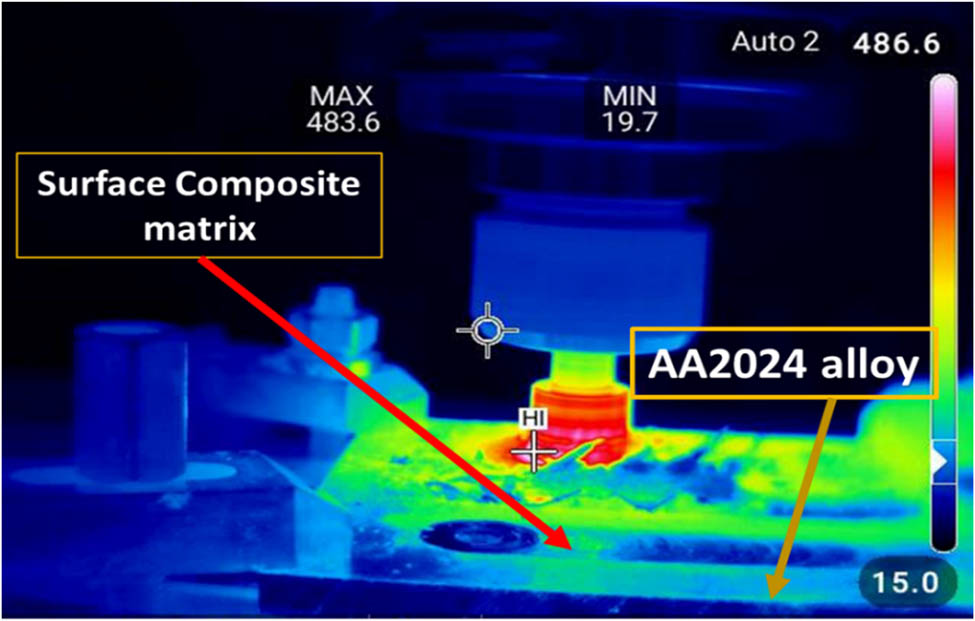
Typical thermographic image of the fabricated surface composite using FSP.
The TMAZ was the only zone that distorted and lost its grain structure during the heat cycling process. Adding hybrid nanoparticles to the SZ boosted the refining activity, resulting in fine, equiaxed grain structures in the produced nanocomposite’s SZs. The average grain sizes in the stirred zones of the unreinforced alloy and the hybrid composites are shown in Table 2.
Typical BM grain and agitated zone sizes following the addition of different nanoparticle reinforcements and FSP
| AA2024 | AA2024/NbC | AA2024/TaC | AA2024/NbC_TaC | |
|---|---|---|---|---|
| Avg. grain size (μm) | 165.26 | 8.05 | 7.15 | 5.3 |
| SD (μm) | 25.8 | 1.18 | 1.43 | 1.08 |
The average grain size was also used for the intercept method. First, a random straight line was drawn through a micrograph. Then, the number of grain boundaries intersecting the line was counted. The average grain size was determined by dividing the number of intersections by the actual line length, which was the measured length divided by the magnification used. For example, the average grain sizes of AA2024 and its hybrid composite (AA2024/NbC_TaC) were 165.26 μm and 5.3 μm, respectively, meaning that the average grain size of the fabricated nanocomposite’s surface was reduced by more than 30 times (96.7%). The decreased SD indicates that following FSP, the SZ included homogenous equiaxed grains (Figure 4).

Optical microscope images of the (a) wrought AA2024, (b) orientation of the AA2024/TaC_NbC composite processed zone, and microstructure refinement distributions of the (c) AA2024/TaC and (d) AA2024/NbC monocomposites, and (e) AA2024/TaC_NbC hybrid composite.
Packed ceramic particles are attached to the plasticized aluminum alloy through perforations. Because of the density differential between the ceramic particles and the molten aluminum, the reinforcement particles migrated naturally inside the aluminum matrix, resulting in particle segregation and clumping, as shown in Figure 5. The free mobility of the particles created by the density gradient was absent during FSP because it was accomplished in a solid state without liquefying the base alloy.
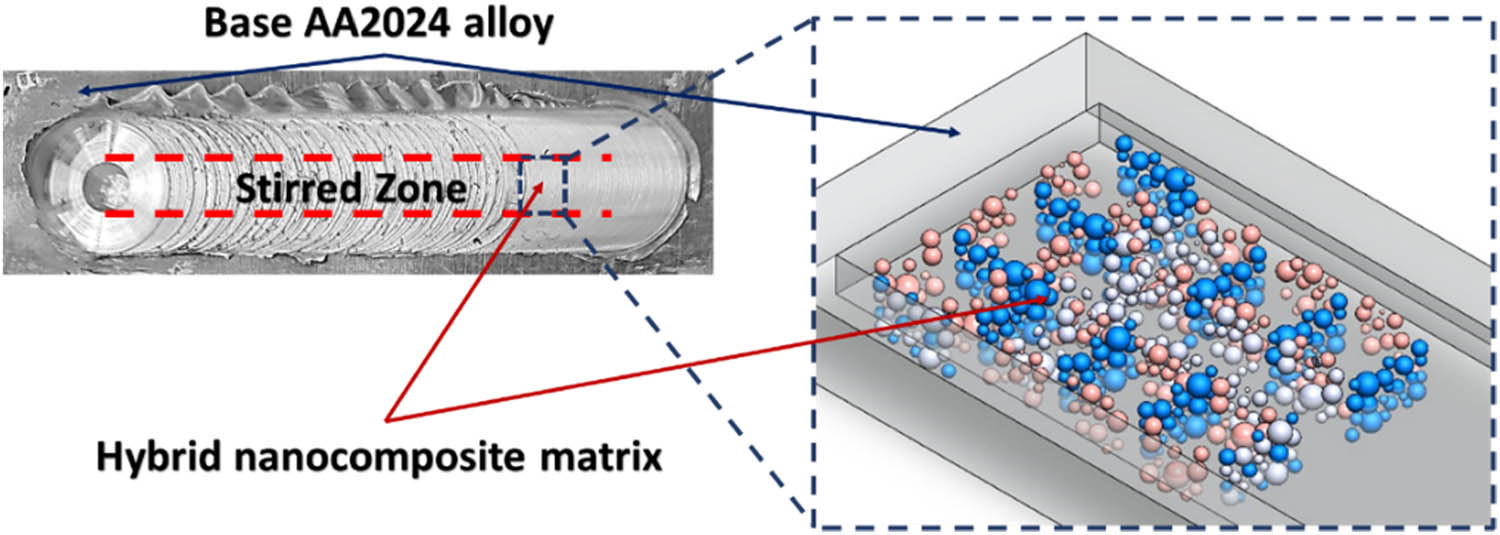
Illustration of the nanoparticle distribution inside the stirred zone.
The action of the FSP and the addition of reinforcing nanoparticles resulted in the controlled grain growth of elongated grains in the rolled aluminum alloy. According to the Zener pinning principle, the scattered particles present in the second phase may have helped maintain grain boundaries during shifting due to recrystallization and grain development.
As seen in Figure 6, the reinforcing particle distribution in the composites was generally homogenous, which may be attributed to the processing parameters and hole patterns that allowed particles to be uniformly distributed. Most of the reinforcing particles were restricted inside the grain boundaries, and there was no particle segregation or structure at the grain boundaries. Energy-dispersive X-ray spectroscopy (EDS) was used to analyze the hybrid composite matrix, including the SEM images and the EDS spectra. EDS elemental mapping was used to identify the presence of reinforcing particles, as indicated in Figure 7.
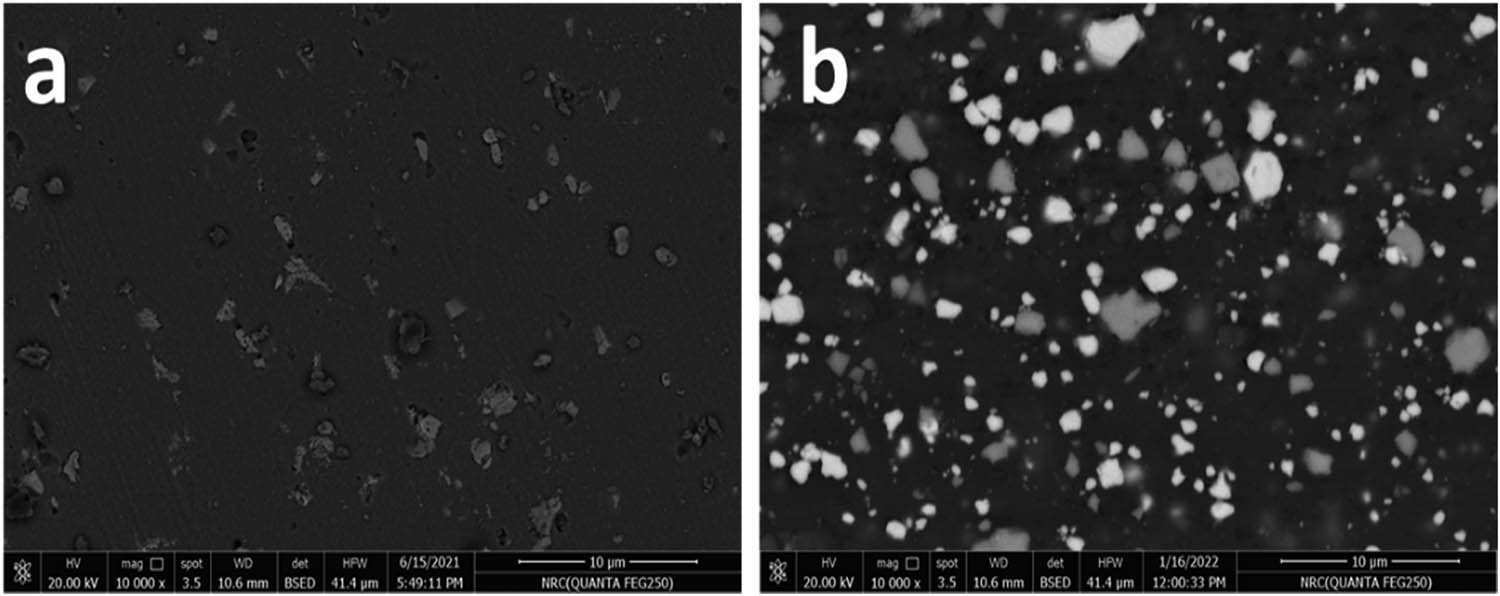
SEM images of the (a) AA2024/TaC monocomposite and (b) AA2024/TaC_NbC hybrid composite.

SEM images of the (a) AA2024/TaC_NbC hybrid nanocomposite and (b) its elemental map. (c) EDS analysis and element intensity. Elemental maps of (d) carbon, (e) tantalum, and (f) niobium.
The EDS of the hybrid composite was enhanced with equal amounts of TaC and NbC particles. Image mapping indicated that the reinforcing particles were evenly distributed throughout the AA2024 matrix. Table 3 summarizes the distribution of the reinforced particles in the matrix, calculated using ImageJ software.
The distribution of the percentage of the reinforced particles in the stirred zone
| Base matrix area (%/µm2) | Particles (%/µm2) | Avg. size (µ2) | |
|---|---|---|---|
| AA2024/NbC | 87.46 | 12.54 | 2.80 |
| AA2024/TaC | 88.07 | 11.93 | 1.75 |
| AA2024/NbC_TaC | 84.42 | 15.58 | 18.36 |
3.2 Phase evolution
In general, XRD analysis is one of the most effective methods for determining the structure of prepared materials. Figure 8 shows the XRD analysis of AA2024, AA2024/TaC, AA2024/NbC, and AA2024/TaC_NbC. According to card number 01-089-4037, the presence of Al (i.e., its cubic crystal structure) is commonly indicated by peaks at 38:43°, 44:68°, 65:07°, and 66:59°. However, some undissolved coarse precipitates distributed on the grain boundaries of the base alloy were identified (intermetallic compounds CuAl2 and CuMgAl2, according to card numbers 89-1981 and 28-0014). In addition, according to card numbers 89-2870 and 89-3830, the TaC and NbC ceramic phases appeared in the AA2024/TaC and AA2024/NbC composite samples, respectively, and both appeared in the hybrid composite. Interestingly, the addition of the ceramic reinforcements resulted in the dissolution of the intermetallic compounds in the Al lattice, which led to a decrease in the Al peaks’ intensity, especially in the hybrid composite (Figure 9). The results showed that the crystallite size tended to decrease. At the same time, dislocation density increased after ceramics were added, especially in the hybrid composite, due to the refinement of the Al grains and their diffusion activation energy [36,37]. The values of the crystallite sizes of the Al alloy, AA2024/TaC, AA2024/NbC, and AA2024/TaC_NbC were 24.04, 20.13, 19.36, and 16.80 nm, respectively, while the dislocation densities were 1.76 × 10−3, 2.48 × 10−3, 2.69 × 10−3, and 3.59 × 10−3%, respectively.
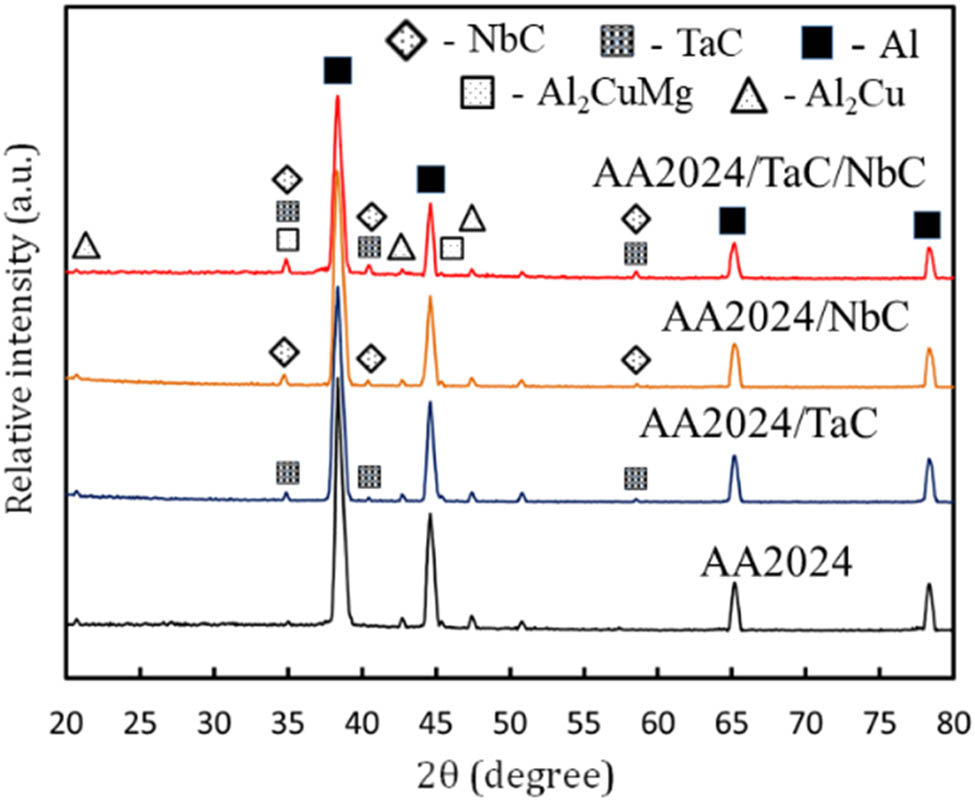
XRD patterns of AA2024, AA2024/TaC, AA2024/NbC, and AA2024/TaC_NbC.
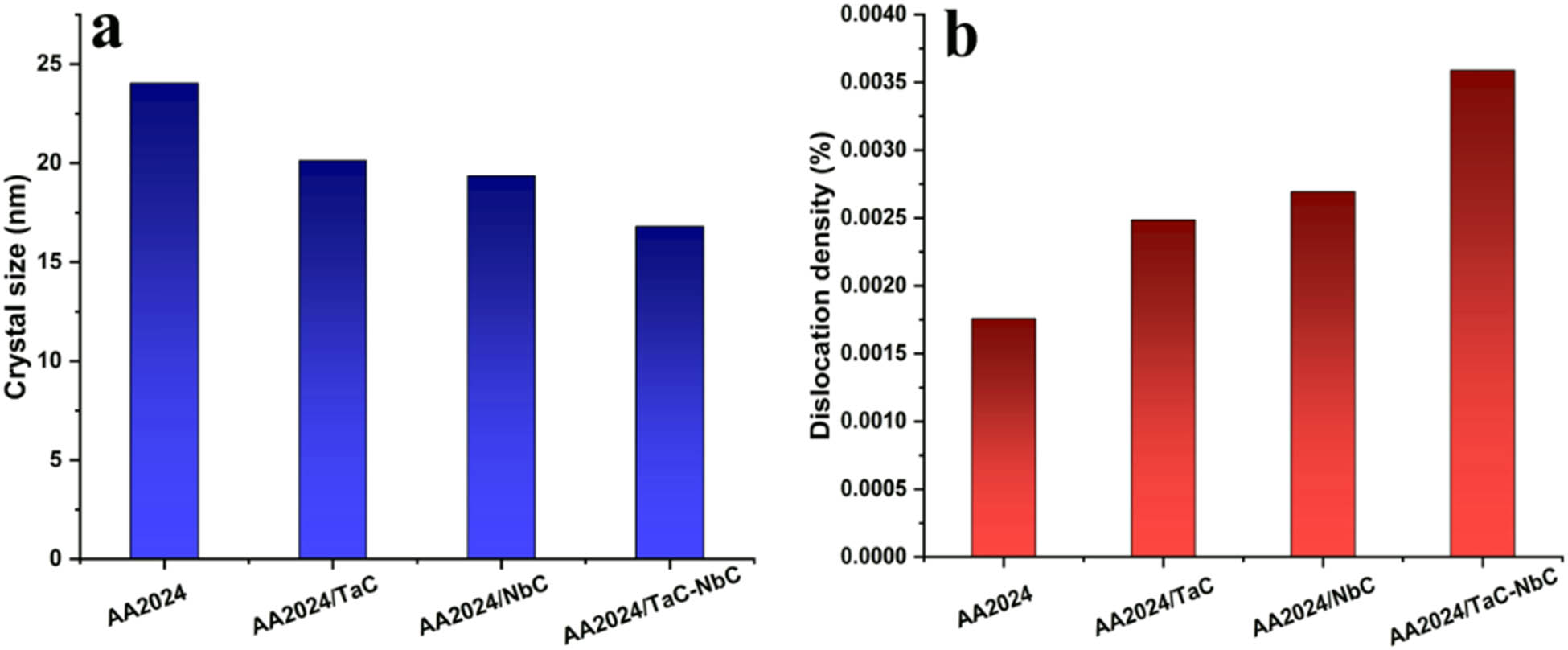
Effect of ceramic reinforcement on (a) crystal size and (b) dislocation density.
3.3 Thermal expansion behavior
Figure 10 shows the thermal expansion (ΔL/L) behavior of AA2024 and its composites at temperatures ranging from 22 to 500°C. The ΔL/L value of the base alloy increased with temperature but decreased when ceramics were added, especially in the case of the AA2024/TaC_NbC hybrid. The coefficient of thermal expansion (CTE), one of the most significant features of the investigated materials, was obtained by measuring the slopes of the lines in Figure 10 for all samples. The effect of adding TaC, NbC, and TaC_NbC reinforcements on the CTE is shown in Figure 11. For example, the CTE of the base alloy was 22.9 × 10−6/°C; after adding TaC, NbC, and TaC_NbC, the values dropped significantly to 19.8 × 10−6, 18.4 × 10−6, and 15.2 × 10−6/°C, respectively. These decreases in ΔL/L and CTE values were caused by the different CTEs of the ceramic reinforcement, equal to 6.3 × 10−6 and 6.7 × 10−6/°C, respectively, and the base alloy (23.2 × 10−6/°C) [37]. On the other hand, residual stresses generated from the thermal mismatch between the Al alloy and its reinforcements played an active role in determining the prepared composite thermal expansion behavior [38,39].
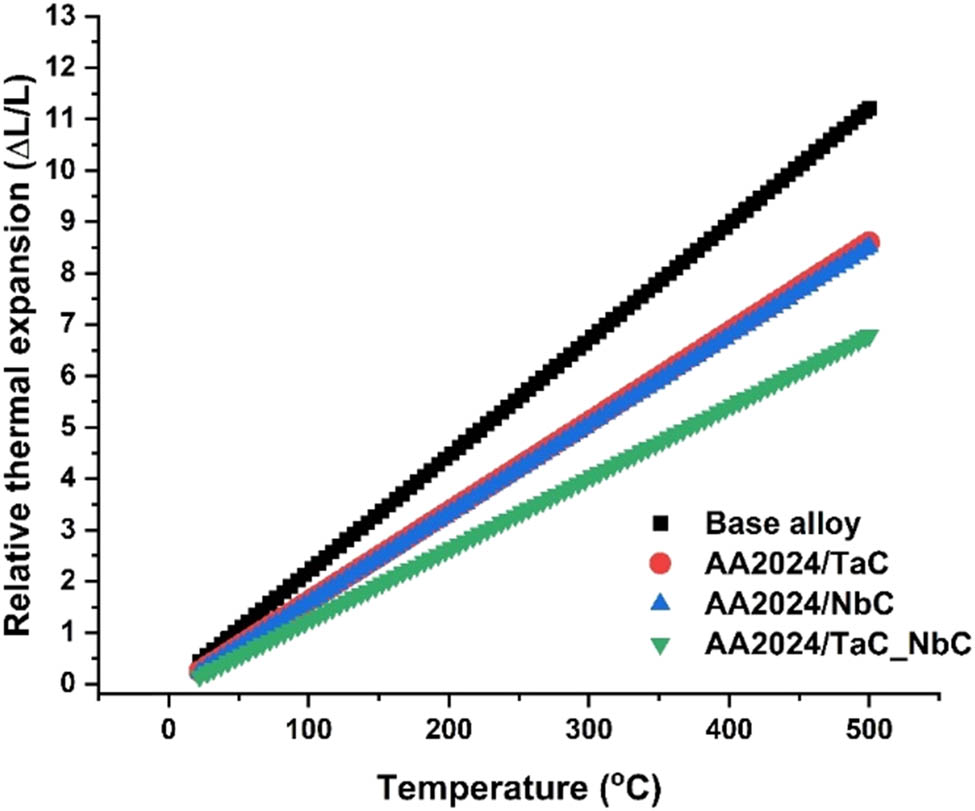
Thermal expansion behavior of AA2024 and its composites.

CTE values of AA2024 and its composites.
Thus, the linear decrease in the CTE of the Al alloy after adding TaC or/and NbC particles is the main reason for the composites’ thermal stability. Notably, the linear reduction in the CTE of AA2024 caused the formation of thermally stable composites, underlining the impact of hybrid composites in significantly increasing the stability of AA2024.
3.4 Mechanical properties
3.4.1 Compressive behavior
Figure 12 displays the stress–strain curve obtained through compression tests of AA2024 and its composites. The CS, YS, ultimate compressive strength (UCS), and E values of the composites are shown in Figure 13. Significant improvements in strength between the composites and AA2024 can be seen. For example, the UCS of the base alloy was 396 MPa; after adding TaC, NbC, and TaC_NbC, the values rose to 456.1, 462, and 477.7 MPa, respectively. In the case of E, the values decreased. It is important to note that the values of UCS, CS, and YS are affected by several parameters [40,41].
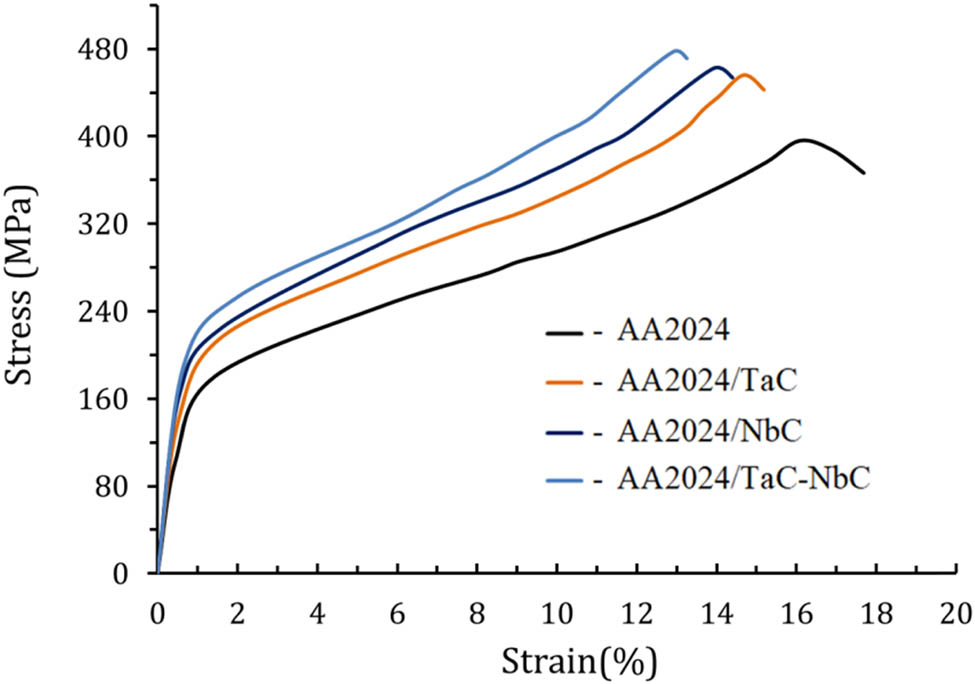
Compression curves of AA2024 and its composites.
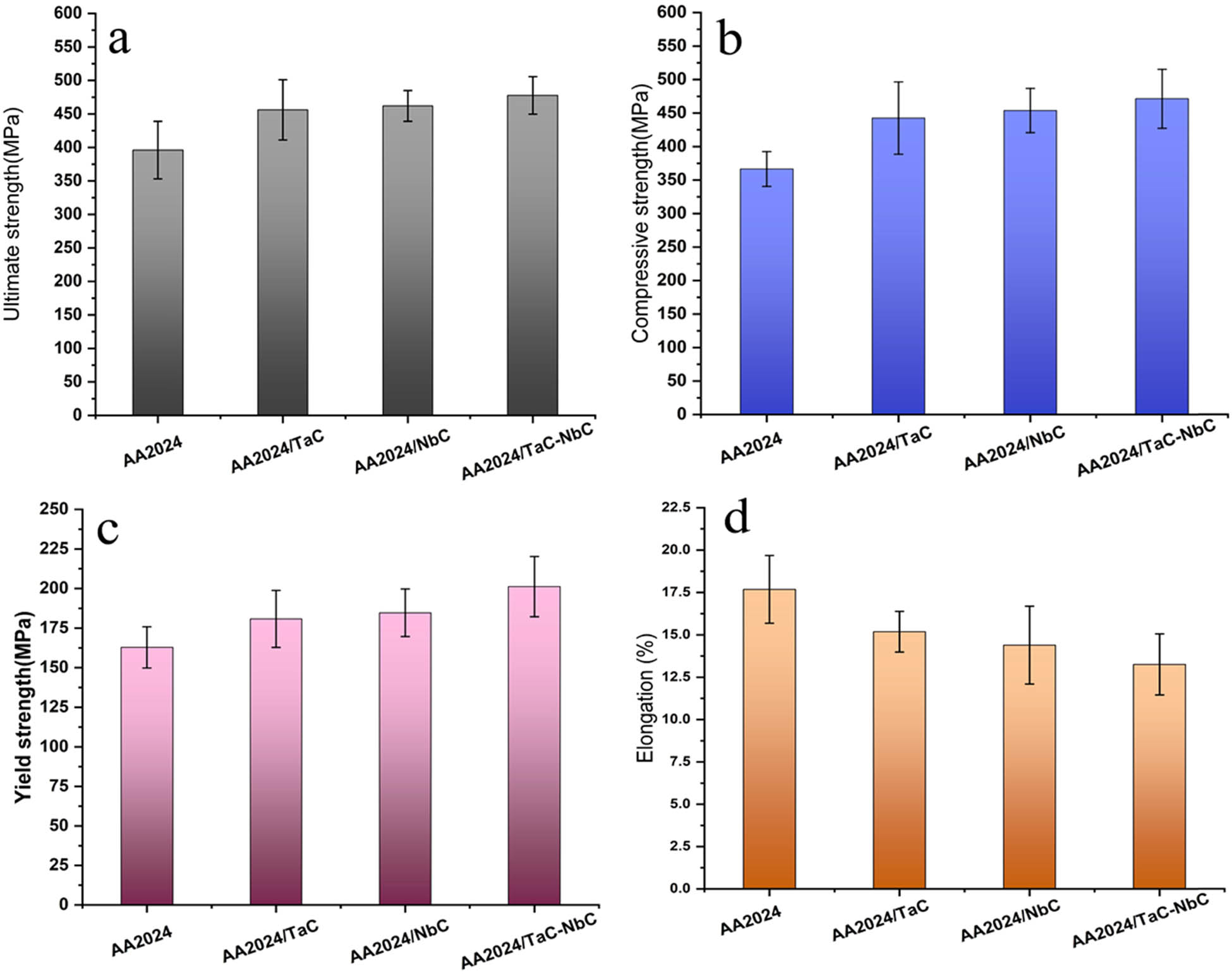
(a) UCS, (b) CS, (c) YS, and (d) E of AA2024 and its composites.
One common reason why Al alloys harden is that high-strength ceramic phase particles dispersed in a ductile matrix can act as dislocation barriers, resulting in improved mechanical behavior. Orowan strengthening is the mechanism that results from the dispersion of TaC and NbC reinforcements in the Al alloy matrix. Importantly, the inclusion of TaC and/or NbC in the Al alloy matrix prevents dislocation movement during the dispersion strengthening process.
In particular, grain size refinement is one of the most effective techniques used to enhance the strength of materials. As TaC and NbC reinforcements are added to Al alloys, the grain sizes of the composites decrease, and reinforcements are found at the grain boundaries of the Al alloy. The Hall–Petch formula can be used to show the relationship between strength (σ) and grain size (d):
where K is the Hall–Petch coefficient.
The huge CTE discrepancy between the TaC and NbC additives (6.3 × 10−6 and 7.83 × 10−6/°C, respectively) and Al (22.8 × 10−6/°C) causes desired geometrical dislocations as well as induced residual thermal stresses. Thermal stresses, when in contact with the reinforcing matrix, cause harder plastic to deform, increasing the microhardness and strength.
Conversely, brittle TaC and/or NbC particles in composites stimulate the formation and propagation of microcracks, resulting in a noticeable elongation decrease. Furthermore, the presence of ceramics reduces the flow capacity of AA2024 and thus reduces elongation more [41]. The decrease in elongation of the hybrid composite was 24.8% greater than the others, which may have been due to the aggregation of the reinforced ceramic particles at the grain boundaries, leading to the increased creation of microcracks.
3.4.2 Hardness behavior
The Vickers microhardness (HV0.1) profiles for AA2024 and the fabricated composite surfaces are shown in Figure 14. The base alloy averaged 132.5 HV0.1, as can be seen. Compared with the base matrix, the AA2024/TaC _NbC hybrid composite’s surface showed a remarkable 51% increase in hardness. The hardness of the composite surface increased dramatically after the FSP because of refinement and the homogeneous distribution of the reinforcements. The mechanical and physical properties of the secondary TaC reinforcement particles are responsible for this. The AA2024/TaC and AA2024/NbC monocomposites’ surfaces exhibited average SZ hardness values of 155 and 163 HV, respectively, corresponding to increases of 17.5 and 23.4%.
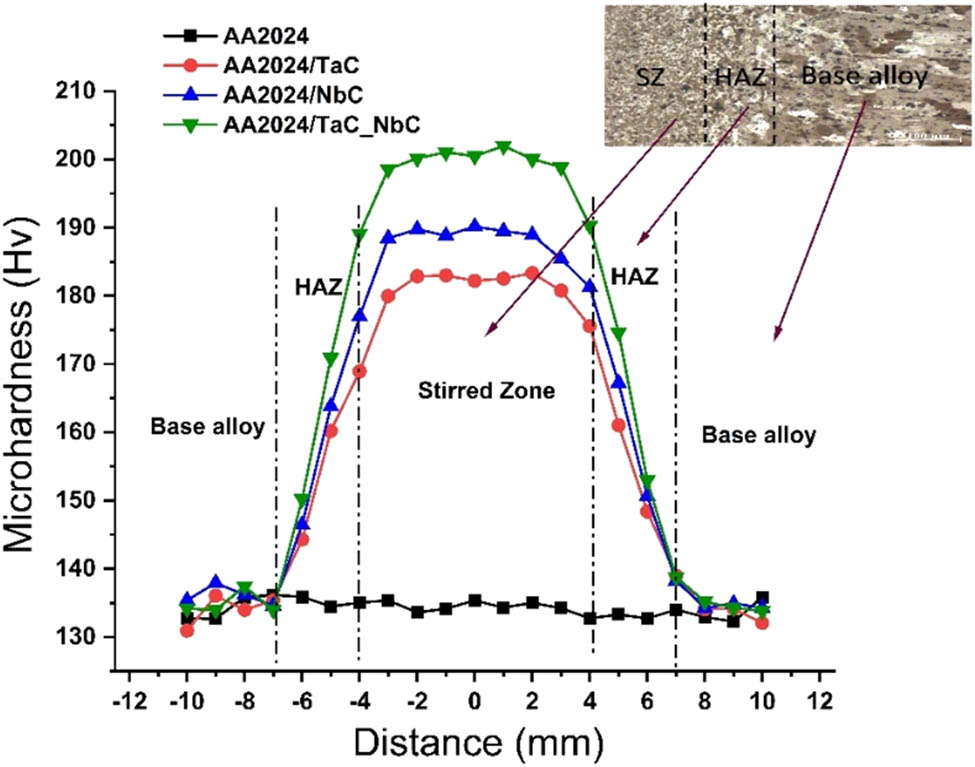
Microhardness profile distributions of AA2024 and its composites.
Figure 15 illustrates the microhardness of AA2024 and its composites when heat-treated at 150°C for different aging periods (1–21 h). Note that for all samples, microhardness increased as time passed but then decreased after individual peaks. We noticed four microhardness stages as a function of artificial aging time [42,43]:
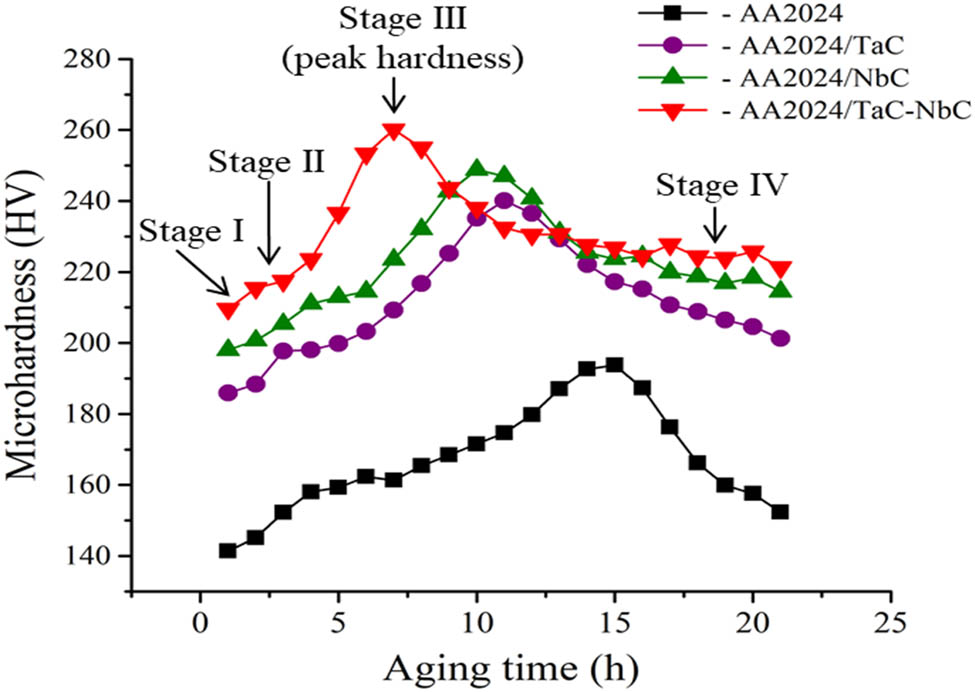
Microhardness of the samples as a function of artificial aging time.
Stage I: At the start of the aging process, the rapid initial microhardness produced by the alloy solution treatment was essentially homogenous, with no large precipitating particles at the grain boundaries (after 1 h).
Stage II: With an increase in aging time, the hardness’s temporary stability indicates the microhardness’s stability (microhardness plateau).
Stage III: The continuing increase in microhardness indicated the formation of gunnier-preston (GP) zones and cohesive intermediate precipitates (θ′ and θ″). Due to the GP zones, almost all copper was removed from the solution, and solution strengthening almost disappeared. Cohesion strains surrounding the GP zones and θ″ precipitates create stresses that limited the dislocation motion in cohesion stress hardening (i.e., peak hardness).
Stage IV: In this final stage, the precipitated particles in the alloy became coarser because of the extended heating period (over-aging). The pinning effect of the coarse particles diminished, allowing dislocation and more free movement. As a result, the microhardness of the alloy decreased.
Surprisingly, the results indicated that adding TaC and/or NbC ceramic reinforcements to the Al alloy reduced the time needed to reach maximal microhardness. For AA2024, the time needed to reach peak hardness was about 14.4 h; its composites containing TaC, NbC, and TaC_NbC required about 12.2, 10.0, and 5.0 h, respectively. This time decrease can be attributed to the dislocation of the Al alloy matrix, which reduced the incubation time for the heterogeneous nucleation of precipitates and the increased diffusion of the solute into a composite matrix. This could be due to the larger number of particle–matrix interfaces (in the case of a composite being reinforced with fine particles), leading to more dislocation (precipitation nucleating sites) and promoting hardening from age, which prevented softening by restricting the coarseness of the precipitate [44,45].
3.5 Electrical conductivity
The effect on AA2024’s electrical conductivity by adding TaC and/or NbC is shown in Figure 16. As shown, the electrical conductivity of the composites was lower than that of the Al alloy, which was caused by the addition of TaC and NbC. Interestingly, TaC by itself has metallic electrical conductivity in magnitude and temperature: this superconductor has an extremely high transition temperature of 10.35 K. Thus, the AA2024/TaC composite demonstrated higher electrical conductivity than the AA2024/NbC and AA2024/TaC_NbC composites. Ceramic particles deformed the structure of the composites and thus led to the formation of barriers that impeded the movement of free electrons, lessening conductivity [46]. Furthermore, the aggregation of ceramic reinforcement particles at the grain boundaries of the Al alloy, which can form a grain boundary phase, increased free electron scattering and caused conductivity to decrease. This was especially the case with the hybrid composite containing both TaC and NbC particles [47].
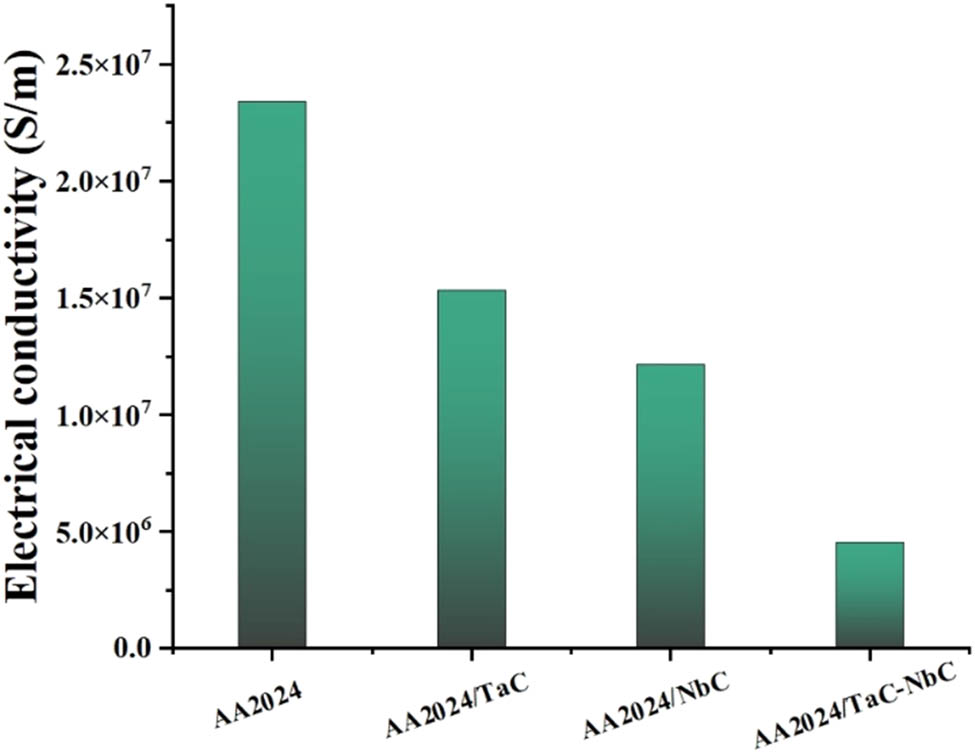
Electrical conductivity of AA2024 and its composites.
Figure 17 shows the relationship between aging time and electrical conductivity. The figure clearly shows that conductivity decreased as time increased but increased again as more time passed. In the initial stage of the aging process, the solution (in this case, a supersaturated solution) had low conductivity because of fewer free electrons due to the particle size mismatch at many local scattering sites between the solute and the solvent. Even as the solute was removed from the Al matrix as time passed, its conductivity continued to decrease because of the formation of coherent GP zones and precipitated phases (i.e., θ′ and θ″). They remained at the grain boundaries, resulting in increased electron scattering (peak hardness). During the averaging phase, the precipitates lost coherency and grew in size. Conductivity increased due to a considerable loss of solute, mainly Cu and Mg, from the Al alloy. Due to the bulky precipitate size, the lattice arrangement over the length became more prominent than the average electron-free path, which enhanced conductivity.
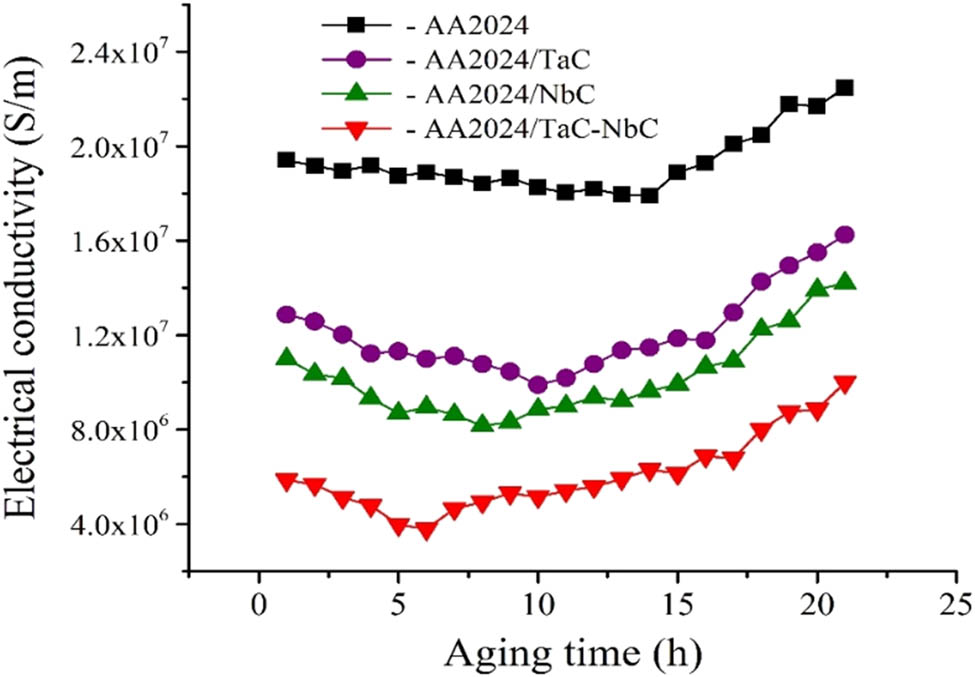
Electrical conductivity of the samples as a function of artificial aging time.
4 Conclusion
The current study successfully fabricated monocomposite and hybrid nanocomposite aluminum matrices using FSP. TaC and NbC played important roles in improving the alloy’s microstructure, mechanical properties, and hardness. From the results, we can conclude the following:
TaC and NbC heavy ceramic reinforcing nanoparticles have the primary effect of refining microstructure during FSP. Grain reduction reached 33% in the hybrid nanocomposite AA2024/TaC_NbC. Moreover, homogenous dispersion of these particles in the composite matrix was observed.
The addition of ceramic reinforcements was responsible for precipitation (i.e., the temporary formation of Al2Cu and Al2CuMg) and the decrease in the crystal lattice due to dislocation.
The CTE of AA2024 was reduced by about 38.5% because of TaC_NbC hybrid reinforcement, indicating high-dimensional stability.
The composites showed superior mechanical properties, especially the hybrid, due to the integration and combination of TaC and NbC throughout the nanoparticle manufacturing process.
The microhardness and ultimate strength of the hybrid composites equaled 200 HV and 477.7 MPa, respectively, about 1.48 and 1.21 times better than AA2024 (i.e., 134.8 HV and 396 MPa, respectively).
The content of the precipitation phases was controlled by the aging period, which caused microhardness to increase and decrease. Electrical conductivity behaved conversely.
Compared to AA2024 by itself, adding reinforcements accelerated the composites’ aging process.
After 21 h of aging, the maximum electrical conductivities of AA2024 and its composites were 2.25 × 107 and 9.99 × 106 S/m, respectively.
Acknowledgments
The authors extend their appreciation to the Deputyship of Research & Innovation, Ministry of Education in Saudi Arabia, for funding this research work through the project number IFPIP:844-135-1442 and King Abdulaziz University, Jeddah, Saudi Arabia.
-
Funding information: Deputyship of Research & Innovation, Ministry of Education in Saudi Arabia, for funding this research work through the project number IFPIP:844-135-1442 and King Abdulaziz University, Jeddah, Saudi Arabia.
-
Author contributions: All authors have accepted responsibility for the entire content of this manuscript and approved its submission.
-
Conflict of interest: The authors state no conflict of interest.
References
[1] Jalilvand MM, Mazaheri Y. Effect of mono and hybrid ceramic reinforcement particles on the tribological behavior of the AZ31 matrix surface composites developed by friction stir processing. Ceram Int. 2020;46:20345–56.10.1016/j.ceramint.2020.05.123Search in Google Scholar
[2] Moustafa EB, Khalil AM, Ahmed HM, Hefni M, Mosleh AO. Microstructure, hardness, and wear behavior investigation of the surface nanocomposite metal matrix reinforced by silicon carbide and alumina nanoparticles. J Mineral Met Mater Eng. 2021;7:57–62.Search in Google Scholar
[3] Rajendran C, Srinivasan K, Balasubramanian V, Balaji H, Selvaraj P. Effect of tool tilt angle on strength and microstructural characteristics of friction stir welded lap joints of AA2014-T6 aluminum alloy. Trans Nonferrous Met Soc China. 2019;29(9):1824–35.10.1016/S1003-6326(19)65090-9Search in Google Scholar
[4] BME. Dynamic characteristics study for surface composite of ammncs matrix fabricated by friction stir process. Mater (Basel). 2018;11:7.10.3390/ma11071240Search in Google Scholar
[5] AbuShanab WS, Abd Elaziz M, Ghandourah EI, Moustafa EB, Elsheikh AH. A new fine-tuned random vector functional link model using Hunger games search optimizer for modeling friction stir welding process of polymeric materials. J Mater Res Technol. 2021;14:1482–93.10.1016/j.jmrt.2021.07.031Search in Google Scholar
[6] Abushanab WS, Moustafa EB, Melaibari AA, Kotov AD, Mosleh AO. A novel comparative study based on the economic feasibility of the ceramic nanoparticles role’s in improving the properties of the AA5250 nanocomposites. Coatings. 2021;11(8):977.10.3390/coatings11080977Search in Google Scholar
[7] Maamoun AH, Veldhuis SC, Elbestawi M. Friction stir processing of AlSi10Mg parts produced by selective laser melting. J Mater Process Technol. 2019;263:308–20.10.1016/j.jmatprotec.2018.08.030Search in Google Scholar
[8] Moustafa E. Effect of multi-pass friction stir processing on mechanical properties for AA2024/Al(2)O(3) nanocomposites. Materials(Basel). 2017;10:9.Search in Google Scholar
[9] Rajendran C, Srinivasan K, Balasubramanian V, Balaji H, Selvaraj P. Effect of post weld heat treatment on strength and microstructure of friction stir welded lap joints of AA2014-T6 aluminum alloy. Met Sci Heat Treat. 2019;61(5-6):305–10.10.1007/s11041-019-00421-2Search in Google Scholar
[10] Akbari M, Asadi P, Zolghadr P, Khalkhali A. Multicriteria optimization of mechanical properties of aluminum composites reinforced with different reinforcing particles type. Proc Inst Mech Eng Part E J Process Mech Eng. 2017;232(3):323–37.10.1177/0954408917704994Search in Google Scholar
[11] Shojaeefard MH, Khalkhali A, Akbari M, Asadi P. Investigation of friction stir welding tool parameters using FEM and neural network. Proc Inst Mech Eng Part L: J Mater Des Appl. 2013;229(3):209–17.10.1177/1464420713509075Search in Google Scholar
[12] Eskandari H, Taheri R. A novel technique for development of aluminum alloy matrix/TiB2/Al2O3 hybrid surface nanocomposite by friction stir processing. Procedia Mater Sci. 2015;11:503–8.10.1016/j.mspro.2015.11.080Search in Google Scholar
[13] Karpasand F, Abbasi A, Ardestani M. Effect of amount of TiB2 and B4C particles on tribological behavior of Al7075/B4C/TiB2 mono and hybrid surface composites produced by friction stir processing. Surf Coat Technol. 2020;390:390.10.1016/j.surfcoat.2020.125680Search in Google Scholar
[14] Moustafa EB, Melaibari A, Basha M. Wear and microhardness behaviors of AA7075/SiC-BN hybrid nanocomposite surfaces fabricated by friction stir processing. Ceram Int. 2020;46:16938–43.10.1016/j.ceramint.2020.03.274Search in Google Scholar
[15] Moustafa EB, Taha MA. Preparation of high strength graphene reinforced Cu-based nanocomposites via mechanical alloying method: microstructural, mechanical and electrical properties. Appl Phys A. 2020;126(3):220.10.1007/s00339-020-3412-0Search in Google Scholar
[16] Ostovan F, Amanollah S, Toozandehjani M, Shafiei E. Fabrication of Al5083 surface hybrid nanocomposite reinforced by CNTs and Al2O3 nanoparticles using friction stir processing. J Composite Mater. 2019;54(8):1107–17.10.1177/0021998319874849Search in Google Scholar
[17] Rana HG, Badheka VJ, Kumar A. Fabrication of Al7075/B4C surface composite by novel friction stir processing (FSP) and investigation on wear properties. Procedia Technol. 2016;23:519–28.10.1016/j.protcy.2016.03.058Search in Google Scholar
[18] Rajendran C, Srinivasan K, Balasubramanian V, Balaji H, Selvaraj P. Identifying combination of friction stir welding parameters to maximize strength of lap joints of AA2014-T6 aluminium alloy. Australian J Mech Eng. 2019;17(2):64–75.10.1080/14484846.2017.1304843Search in Google Scholar
[19] Moustafa EB, AbuShanab WS, Ghandourah E, Taha MA. Microstructural, mechanical and thermal properties evaluation of AA6061/Al2O3-BN hybrid and mono nanocomposite surface. J Mater Res Technol. 2020;9(6):15486–95.10.1016/j.jmrt.2020.11.010Search in Google Scholar
[20] Dieguez T, Burgueño A, Svoboda H. Superplasticity of a friction stir processed 7075-T651 aluminum alloy. Proc Mater Sci. 2012;1:110–7.10.1016/j.mspro.2012.06.015Search in Google Scholar
[21] Moustafa E. Effect of multi-pass friction stir processing on mechanical properties for AA2024/Al(2)O(3) nanocomposites. Materials. 2017;10(9):1053.10.3390/ma10091053Search in Google Scholar PubMed PubMed Central
[22] Essam B, Moustafa SM, Abdel-Wanis S, Mahmoud T. Surface composite defects of Al/Al2O3 metal matrix fabricated by friction stir processing. J Mater Sci Surf Eng. 2017;5(2):524–7.Search in Google Scholar
[23] Umanath K, Selvamani ST, Palanikumar K, Sabarikreeshwaran R. Dry sliding wear behaviour of AA6061-T6 reinforced SiC and Al2O3 particulate hybrid composites. Proc Eng. 2014;97:694–702.10.1016/j.proeng.2014.12.299Search in Google Scholar
[24] Moustafa EB, Abushanab WS, Melaibari A, Yakovtseva O, Mosleh AO. The effectiveness of incorporating hybrid reinforcement nanoparticles in the enhancement of the tribological behavior of aluminum metal matrix composites. JOM. 2021;73:4338–48.10.1007/s11837-021-04955-wSearch in Google Scholar
[25] Moustafa EB, Taha MA. Evaluation of the microstructure, thermal and mechanical properties of Cu/SiC nanocomposites fabricated by mechanical alloying. Int J Minerals, Metall Mater. 2021;28(3):475–86.10.1007/s12613-020-2176-zSearch in Google Scholar
[26] Akbari M, Shojaeefard MH, Asadi P, Khalkhali A. Wear performance of A356 matrix composites reinforced with different types of reinforcing particles. J Mater Eng Perform. 2017;26(9):4297–310.10.1007/s11665-017-2901-6Search in Google Scholar
[27] Samal P, Vundavilli PR, Meher A, Mahapatra MM. Fabrication and mechanical properties of titanium carbide reinforced aluminium composites. Mater Today: Proc. 2019;18:2649–55.10.1016/j.matpr.2019.07.125Search in Google Scholar
[28] Khalil KA, Sherif ES, Nabawy AM, Abdo HS, Marzouk WW, Alharbi HF Titanium carbide nanofibers-reinforced aluminum compacts, a new strategy to enhance mechanical properties. Materials. 2016;9:510.3390/ma9050399Search in Google Scholar PubMed PubMed Central
[29] Abdel Aziz SS, Abulkhair H, Moustafa EB. Role of hybrid nanoparticles on thermal, electrical conductivity, microstructure, and hardness behavior of nanocomposite matrix. J Mater Res Technol. 2021;13:1275–84.10.1016/j.jmrt.2021.05.034Search in Google Scholar
[30] Moustafa EB, Melaibari A, Alsoruji G, Khalil AM, Mosleh AO. Tribological and mechanical characteristics of AA5083 alloy reinforced by hybridising heavy ceramic particles Ta2C & VC with light GNP and Al2O3 nanoparticles. Ceram Int. 2021;48(4):4710–21.10.1016/j.ceramint.2021.11.007Search in Google Scholar
[31] Emamian S, Awang M, Yusof F, Hussain P, Mehrpouya M, Kakooei S, et al. A review of friction stir welding pin profile. In 2nd International Conference on Mechanical, Manufacturing and Process Plant Engineering; 2017. p. 1–18.10.1007/978-981-10-4232-4_1Search in Google Scholar
[32] AbuShanab WS, Moustafa EB. Effects of friction stir processing parameters on the wear resistance and mechanical properties of fabricated metal matrix nanocomposites (MMNCs) surface. J Mater Res Technol. 2020;9(4):7460–71.10.1016/j.jmrt.2020.04.073Search in Google Scholar
[33] Rasha A, Youness MAT. Study of mechanical properties and wear behavior of nano-ZrO2-hardened Al2024 matrix composites prepared by stir cast method. Egypt J Chem. 2021;65(2):307–13.Search in Google Scholar
[34] Alatawi AS, Alturki AM, Soliman GM, Abulyazied DE, Taha MA, Youness RA. Improved toughness, electrical conductivity and optical properties of bioactive borosilicate glasses for orthopedic applications. Appl Phys A. 2021;127:12.10.1007/s00339-021-05116-1Search in Google Scholar
[35] Taha MA, Youness RA, El-Bassyouni GT, Azooz MA. FTIR spectral characterization, mechanical and electrical properties of P2O5-Li2O-CuO glass-ceramics. Silicon. 2020;13(9):3075–84.10.1007/s12633-020-00661-5Search in Google Scholar
[36] Zawrah MF, El-Meligy WM, Saudi HA, Ramadan S, Taha MA. Mechanical and electrical properties of nano Al-matrix composites reinforced with SiC and prepared by powder metallurgy. Biointerface Res Appl Chem. 2022;12(2):2068–83.10.33263/BRIAC122.20682083Search in Google Scholar
[37] Zawrah MF, Abo Mostafa H, Taha MA. Effect of SiC content on microstructure, mechanical and electrical properties of sintered Al–20Si–xSiC nanocomposites fabricated by mechanical alloying. Mater Res Exp. 2019;6:12.10.1088/2053-1591/ab534eSearch in Google Scholar
[38] Moustafa EB, Taha MA. Evaluation of the microstructure, thermal and mechanical properties of Cu/SiC nanocomposites fabricated by mechanical alloying. Int J Minerals Metal Mater. 2021;28(3):475.10.1007/s12613-020-2176-zSearch in Google Scholar
[39] AbuShanab WS, Moustafa EB, Ghandourah E, Taha MA. Effect of graphene nanoparticles on the physical and mechanical properties of the Al2024-graphene nanocomposites fabricated by powder metallurgy. Results Phys. 2020;19:19.10.1016/j.rinp.2020.103343Search in Google Scholar
[40] AbuShanab WS, Moustafa EB, Ghandourah E, Taha MA. The effect of different fly ash and vanadium carbide contents on the various properties of hypereutectic Al–Si alloys-based hybrid nanocomposites. Silicon. 2021;13(8).10.1007/s12633-021-01284-0Search in Google Scholar
[41] Ravi Kumar K, Pridhar T, Balaji VS. Mechanical properties and characterization of zirconium oxide (ZrO2) and coconut shell ash (CSA) reinforced aluminium (Al 6082) matrix hybrid composite. J Alloy Compd. 2018;765:171–9.10.1016/j.jallcom.2018.06.177Search in Google Scholar
[42] Bezzina S, Moustafa EB, Taha MA. Effects of metastable θ′ precipitates on the strengthening, wear and electrical behaviors of Al 2519–SiC/fly ash hybrid nanocomposites synthesized by powder metallurgy technique. Silicon. 2022;14(1).10.1007/s12633-021-01641-zSearch in Google Scholar
[43] Kabir MS, Minhaj TI, Ashrafi EA, Islam MM. The influence of ageing time and temperature on the structure and properties of heat treated A201.0 aluminum alloy. Int J Recent Technol Eng. 2014;3(3):78–83.Search in Google Scholar
[44] Li L, Han Z, Gao M, Li S, Wang H, Kang H, et al. Microstructures, mechanical properties, and aging behavior of hybrid-sized TiB2 particulate-reinforced 2219 aluminum matrix composites. Mater Sci Eng A. 2022;829:142180.10.1016/j.msea.2021.142180Search in Google Scholar
[45] Taha MA, Elkomy GM, Mostafa HA, Gouda ES. Effect of ZrO2 contents and ageing times on mechanical and electrical properties of Al–4.5 wt.% Cu nanocomposites prepared by mechanical alloying. Mater Chem Phys. 2018;206:116–23.10.1016/j.matchemphys.2017.11.058Search in Google Scholar
[46] Taha MA, Youness RA, Ibrahim MA. Evolution of the physical, mechanical and electrical properties of sic-reinforced Al 6061 composites prepared by stir cast method. Biointerface Res Appl Chem. 2020;11(2):8946–56.10.33263/BRIAC112.89468956Search in Google Scholar
[47] Elmahdy M, Abouelmagd G, Mazen AAE. Microstructure and properties of Cu-ZrO2 nanocomposites synthesized by in situ processing. Mater Res. 2018;21:1.10.1590/1980-5373-mr-2017-0387Search in Google Scholar
© 2022 Essam B. Moustafa et al., published by De Gruyter
This work is licensed under the Creative Commons Attribution 4.0 International License.
Articles in the same Issue
- Research Articles
- Theoretical and experimental investigation of MWCNT dispersion effect on the elastic modulus of flexible PDMS/MWCNT nanocomposites
- Mechanical, morphological, and fracture-deformation behavior of MWCNTs-reinforced (Al–Cu–Mg–T351) alloy cast nanocomposites fabricated by optimized mechanical milling and powder metallurgy techniques
- Flammability and physical stability of sugar palm crystalline nanocellulose reinforced thermoplastic sugar palm starch/poly(lactic acid) blend bionanocomposites
- Glutathione-loaded non-ionic surfactant niosomes: A new approach to improve oral bioavailability and hepatoprotective efficacy of glutathione
- Relationship between mechano-bactericidal activity and nanoblades density on chemically strengthened glass
- In situ regulation of microstructure and microwave-absorbing properties of FeSiAl through HNO3 oxidation
- Research on a mechanical model of magnetorheological fluid different diameter particles
- Nanomechanical and dynamic mechanical properties of rubber–wood–plastic composites
- Investigative properties of CeO2 doped with niobium: A combined characterization and DFT studies
- Miniaturized peptidomimetics and nano-vesiculation in endothelin types through probable nano-disk formation and structure property relationships of endothelins’ fragments
- N/S co-doped CoSe/C nanocubes as anode materials for Li-ion batteries
- Synergistic effects of halloysite nanotubes with metal and phosphorus additives on the optimal design of eco-friendly sandwich panels with maximum flame resistance and minimum weight
- Octreotide-conjugated silver nanoparticles for active targeting of somatostatin receptors and their application in a nebulized rat model
- Controllable morphology of Bi2S3 nanostructures formed via hydrothermal vulcanization of Bi2O3 thin-film layer and their photoelectrocatalytic performances
- Development of (−)-epigallocatechin-3-gallate-loaded folate receptor-targeted nanoparticles for prostate cancer treatment
- Enhancement of the mechanical properties of HDPE mineral nanocomposites by filler particles modulation of the matrix plastic/elastic behavior
- Effect of plasticizers on the properties of sugar palm nanocellulose/cinnamon essential oil reinforced starch bionanocomposite films
- Optimization of nano coating to reduce the thermal deformation of ball screws
- Preparation of efficient piezoelectric PVDF–HFP/Ni composite films by high electric field poling
- MHD dissipative Casson nanofluid liquid film flow due to an unsteady stretching sheet with radiation influence and slip velocity phenomenon
- Effects of nano-SiO2 modification on rubberised mortar and concrete with recycled coarse aggregates
- Mechanical and microscopic properties of fiber-reinforced coal gangue-based geopolymer concrete
- Effect of morphology and size on the thermodynamic stability of cerium oxide nanoparticles: Experiment and molecular dynamics calculation
- Mechanical performance of a CFRP composite reinforced via gelatin-CNTs: A study on fiber interfacial enhancement and matrix enhancement
- A practical review over surface modification, nanopatterns, emerging materials, drug delivery systems, and their biophysiochemical properties for dental implants: Recent progresses and advances
- HTR: An ultra-high speed algorithm for cage recognition of clathrate hydrates
- Effects of microalloying elements added by in situ synthesis on the microstructure of WCu composites
- A highly sensitive nanobiosensor based on aptamer-conjugated graphene-decorated rhodium nanoparticles for detection of HER2-positive circulating tumor cells
- Progressive collapse performance of shear strengthened RC frames by nano CFRP
- Core–shell heterostructured composites of carbon nanotubes and imine-linked hyperbranched polymers as metal-free Li-ion anodes
- A Galerkin strategy for tri-hybridized mixture in ethylene glycol comprising variable diffusion and thermal conductivity using non-Fourier’s theory
- Simple models for tensile modulus of shape memory polymer nanocomposites at ambient temperature
- Preparation and morphological studies of tin sulfide nanoparticles and use as efficient photocatalysts for the degradation of rhodamine B and phenol
- Polyethyleneimine-impregnated activated carbon nanofiber composited graphene-derived rice husk char for efficient post-combustion CO2 capture
- Electrospun nanofibers of Co3O4 nanocrystals encapsulated in cyclized-polyacrylonitrile for lithium storage
- Pitting corrosion induced on high-strength high carbon steel wire in high alkaline deaerated chloride electrolyte
- Formulation of polymeric nanoparticles loaded sorafenib; evaluation of cytotoxicity, molecular evaluation, and gene expression studies in lung and breast cancer cell lines
- Engineered nanocomposites in asphalt binders
- Influence of loading voltage, domain ratio, and additional load on the actuation of dielectric elastomer
- Thermally induced hex-graphene transitions in 2D carbon crystals
- The surface modification effect on the interfacial properties of glass fiber-reinforced epoxy: A molecular dynamics study
- Molecular dynamics study of deformation mechanism of interfacial microzone of Cu/Al2Cu/Al composites under tension
- Nanocolloid simulators of luminescent solar concentrator photovoltaic windows
- Compressive strength and anti-chloride ion penetration assessment of geopolymer mortar merging PVA fiber and nano-SiO2 using RBF–BP composite neural network
- Effect of 3-mercapto-1-propane sulfonate sulfonic acid and polyvinylpyrrolidone on the growth of cobalt pillar by electrodeposition
- Dynamics of convective slippery constraints on hybrid radiative Sutterby nanofluid flow by Galerkin finite element simulation
- Preparation of vanadium by the magnesiothermic self-propagating reduction and process control
- Microstructure-dependent photoelectrocatalytic activity of heterogeneous ZnO–ZnS nanosheets
- Cytotoxic and pro-inflammatory effects of molybdenum and tungsten disulphide on human bronchial cells
- Improving recycled aggregate concrete by compression casting and nano-silica
- Chemically reactive Maxwell nanoliquid flow by a stretching surface in the frames of Newtonian heating, nonlinear convection and radiative flux: Nanopolymer flow processing simulation
- Nonlinear dynamic and crack behaviors of carbon nanotubes-reinforced composites with various geometries
- Biosynthesis of copper oxide nanoparticles and its therapeutic efficacy against colon cancer
- Synthesis and characterization of smart stimuli-responsive herbal drug-encapsulated nanoniosome particles for efficient treatment of breast cancer
- Homotopic simulation for heat transport phenomenon of the Burgers nanofluids flow over a stretching cylinder with thermal convective and zero mass flux conditions
- Incorporation of copper and strontium ions in TiO2 nanotubes via dopamine to enhance hemocompatibility and cytocompatibility
- Mechanical, thermal, and barrier properties of starch films incorporated with chitosan nanoparticles
- Mechanical properties and microstructure of nano-strengthened recycled aggregate concrete
- Glucose-responsive nanogels efficiently maintain the stability and activity of therapeutic enzymes
- Tunning matrix rheology and mechanical performance of ultra-high performance concrete using cellulose nanofibers
- Flexible MXene/copper/cellulose nanofiber heat spreader films with enhanced thermal conductivity
- Promoted charge separation and specific surface area via interlacing of N-doped titanium dioxide nanotubes on carbon nitride nanosheets for photocatalytic degradation of Rhodamine B
- Elucidating the role of silicon dioxide and titanium dioxide nanoparticles in mitigating the disease of the eggplant caused by Phomopsis vexans, Ralstonia solanacearum, and root-knot nematode Meloidogyne incognita
- An implication of magnetic dipole in Carreau Yasuda liquid influenced by engine oil using ternary hybrid nanomaterial
- Robust synthesis of a composite phase of copper vanadium oxide with enhanced performance for durable aqueous Zn-ion batteries
- Tunning self-assembled phases of bovine serum albumin via hydrothermal process to synthesize novel functional hydrogel for skin protection against UVB
- A comparative experimental study on damping properties of epoxy nanocomposite beams reinforced with carbon nanotubes and graphene nanoplatelets
- Lightweight and hydrophobic Ni/GO/PVA composite aerogels for ultrahigh performance electromagnetic interference shielding
- Research on the auxetic behavior and mechanical properties of periodically rotating graphene nanostructures
- Repairing performances of novel cement mortar modified with graphene oxide and polyacrylate polymer
- Closed-loop recycling and fabrication of hydrophilic CNT films with high performance
- Design of thin-film configuration of SnO2–Ag2O composites for NO2 gas-sensing applications
- Study on stress distribution of SiC/Al composites based on microstructure models with microns and nanoparticles
- PVDF green nanofibers as potential carriers for improving self-healing and mechanical properties of carbon fiber/epoxy prepregs
- Osteogenesis capability of three-dimensionally printed poly(lactic acid)-halloysite nanotube scaffolds containing strontium ranelate
- Silver nanoparticles induce mitochondria-dependent apoptosis and late non-canonical autophagy in HT-29 colon cancer cells
- Preparation and bonding mechanisms of polymer/metal hybrid composite by nano molding technology
- Damage self-sensing and strain monitoring of glass-reinforced epoxy composite impregnated with graphene nanoplatelet and multiwalled carbon nanotubes
- Thermal analysis characterisation of solar-powered ship using Oldroyd hybrid nanofluids in parabolic trough solar collector: An optimal thermal application
- Pyrene-functionalized halloysite nanotubes for simultaneously detecting and separating Hg(ii) in aqueous media: A comprehensive comparison on interparticle and intraparticle excimers
- Fabrication of self-assembly CNT flexible film and its piezoresistive sensing behaviors
- Thermal valuation and entropy inspection of second-grade nanoscale fluid flow over a stretching surface by applying Koo–Kleinstreuer–Li relation
- Mechanical properties and microstructure of nano-SiO2 and basalt-fiber-reinforced recycled aggregate concrete
- Characterization and tribology performance of polyaniline-coated nanodiamond lubricant additives
- Combined impact of Marangoni convection and thermophoretic particle deposition on chemically reactive transport of nanofluid flow over a stretching surface
- Spark plasma extrusion of binder free hydroxyapatite powder
- An investigation on thermo-mechanical performance of graphene-oxide-reinforced shape memory polymer
- Effect of nanoadditives on the novel leather fiber/recycled poly(ethylene-vinyl-acetate) polymer composites for multifunctional applications: Fabrication, characterizations, and multiobjective optimization using central composite design
- Design selection for a hemispherical dimple core sandwich panel using hybrid multi-criteria decision-making methods
- Improving tensile strength and impact toughness of plasticized poly(lactic acid) biocomposites by incorporating nanofibrillated cellulose
- Green synthesis of spinel copper ferrite (CuFe2O4) nanoparticles and their toxicity
- The effect of TaC and NbC hybrid and mono-nanoparticles on AA2024 nanocomposites: Microstructure, strengthening, and artificial aging
- Excited-state geometry relaxation of pyrene-modified cellulose nanocrystals under UV-light excitation for detecting Fe3+
- Effect of CNTs and MEA on the creep of face-slab concrete at an early age
- Effect of deformation conditions on compression phase transformation of AZ31
- Application of MXene as a new generation of highly conductive coating materials for electromembrane-surrounded solid-phase microextraction
- A comparative study of the elasto-plastic properties for ceramic nanocomposites filled by graphene or graphene oxide nanoplates
- Encapsulation strategies for improving the biological behavior of CdS@ZIF-8 nanocomposites
- Biosynthesis of ZnO NPs from pumpkin seeds’ extract and elucidation of its anticancer potential against breast cancer
- Preliminary trials of the gold nanoparticles conjugated chrysin: An assessment of anti-oxidant, anti-microbial, and in vitro cytotoxic activities of a nanoformulated flavonoid
- Effect of micron-scale pores increased by nano-SiO2 sol modification on the strength of cement mortar
- Fractional simulations for thermal flow of hybrid nanofluid with aluminum oxide and titanium oxide nanoparticles with water and blood base fluids
- The effect of graphene nano-powder on the viscosity of water: An experimental study and artificial neural network modeling
- Development of a novel heat- and shear-resistant nano-silica gelling agent
- Characterization, biocompatibility and in vivo of nominal MnO2-containing wollastonite glass-ceramic
- Entropy production simulation of second-grade magnetic nanomaterials flowing across an expanding surface with viscidness dissipative flux
- Enhancement in structural, morphological, and optical properties of copper oxide for optoelectronic device applications
- Aptamer-functionalized chitosan-coated gold nanoparticle complex as a suitable targeted drug carrier for improved breast cancer treatment
- Performance and overall evaluation of nano-alumina-modified asphalt mixture
- Analysis of pure nanofluid (GO/engine oil) and hybrid nanofluid (GO–Fe3O4/engine oil): Novel thermal and magnetic features
- Synthesis of Ag@AgCl modified anatase/rutile/brookite mixed phase TiO2 and their photocatalytic property
- Mechanisms and influential variables on the abrasion resistance hydraulic concrete
- Synergistic reinforcement mechanism of basalt fiber/cellulose nanocrystals/polypropylene composites
- Achieving excellent oxidation resistance and mechanical properties of TiB2–B4C/carbon aerogel composites by quick-gelation and mechanical mixing
- Microwave-assisted sol–gel template-free synthesis and characterization of silica nanoparticles obtained from South African coal fly ash
- Pulsed laser-assisted synthesis of nano nickel(ii) oxide-anchored graphitic carbon nitride: Characterizations and their potential antibacterial/anti-biofilm applications
- Effects of nano-ZrSi2 on thermal stability of phenolic resin and thermal reusability of quartz–phenolic composites
- Benzaldehyde derivatives on tin electroplating as corrosion resistance for fabricating copper circuit
- Mechanical and heat transfer properties of 4D-printed shape memory graphene oxide/epoxy acrylate composites
- Coupling the vanadium-induced amorphous/crystalline NiFe2O4 with phosphide heterojunction toward active oxygen evolution reaction catalysts
- Graphene-oxide-reinforced cement composites mechanical and microstructural characteristics at elevated temperatures
- Gray correlation analysis of factors influencing compressive strength and durability of nano-SiO2 and PVA fiber reinforced geopolymer mortar
- Preparation of layered gradient Cu–Cr–Ti alloy with excellent mechanical properties, thermal stability, and electrical conductivity
- Recovery of Cr from chrome-containing leather wastes to develop aluminum-based composite material along with Al2O3 ceramic particles: An ingenious approach
- Mechanisms of the improved stiffness of flexible polymers under impact loading
- Anticancer potential of gold nanoparticles (AuNPs) using a battery of in vitro tests
- Review Articles
- Proposed approaches for coronaviruses elimination from wastewater: Membrane techniques and nanotechnology solutions
- Application of Pickering emulsion in oil drilling and production
- The contribution of microfluidics to the fight against tuberculosis
- Graphene-based biosensors for disease theranostics: Development, applications, and recent advancements
- Synthesis and encapsulation of iron oxide nanorods for application in magnetic hyperthermia and photothermal therapy
- Contemporary nano-architectured drugs and leads for ανβ3 integrin-based chemotherapy: Rationale and retrospect
- State-of-the-art review of fabrication, application, and mechanical properties of functionally graded porous nanocomposite materials
- Insights on magnetic spinel ferrites for targeted drug delivery and hyperthermia applications
- A review on heterogeneous oxidation of acetaminophen based on micro and nanoparticles catalyzed by different activators
- Early diagnosis of lung cancer using magnetic nanoparticles-integrated systems
- Advances in ZnO: Manipulation of defects for enhancing their technological potentials
- Efficacious nanomedicine track toward combating COVID-19
- A review of the design, processes, and properties of Mg-based composites
- Green synthesis of nanoparticles for varied applications: Green renewable resources and energy-efficient synthetic routes
- Two-dimensional nanomaterial-based polymer composites: Fundamentals and applications
- Recent progress and challenges in plasmonic nanomaterials
- Apoptotic cell-derived micro/nanosized extracellular vesicles in tissue regeneration
- Electronic noses based on metal oxide nanowires: A review
- Framework materials for supercapacitors
- An overview on the reproductive toxicity of graphene derivatives: Highlighting the importance
- Antibacterial nanomaterials: Upcoming hope to overcome antibiotic resistance crisis
- Research progress of carbon materials in the field of three-dimensional printing polymer nanocomposites
- A review of atomic layer deposition modelling and simulation methodologies: Density functional theory and molecular dynamics
- Recent advances in the preparation of PVDF-based piezoelectric materials
- Recent developments in tensile properties of friction welding of carbon fiber-reinforced composite: A review
- Comprehensive review of the properties of fly ash-based geopolymer with additive of nano-SiO2
- Perspectives in biopolymer/graphene-based composite application: Advances, challenges, and recommendations
- Graphene-based nanocomposite using new modeling molecular dynamic simulations for proposed neutralizing mechanism and real-time sensing of COVID-19
- Nanotechnology application on bamboo materials: A review
- Recent developments and future perspectives of biorenewable nanocomposites for advanced applications
- Nanostructured lipid carrier system: A compendium of their formulation development approaches, optimization strategies by quality by design, and recent applications in drug delivery
- 3D printing customized design of human bone tissue implant and its application
- Design, preparation, and functionalization of nanobiomaterials for enhanced efficacy in current and future biomedical applications
- A brief review of nanoparticles-doped PEDOT:PSS nanocomposite for OLED and OPV
- Nanotechnology interventions as a putative tool for the treatment of dental afflictions
- Recent advancements in metal–organic frameworks integrating quantum dots (QDs@MOF) and their potential applications
- A focused review of short electrospun nanofiber preparation techniques for composite reinforcement
- Microstructural characteristics and nano-modification of interfacial transition zone in concrete: A review
- Latest developments in the upconversion nanotechnology for the rapid detection of food safety: A review
- Strategic applications of nano-fertilizers for sustainable agriculture: Benefits and bottlenecks
- Molecular dynamics application of cocrystal energetic materials: A review
- Synthesis and application of nanometer hydroxyapatite in biomedicine
- Cutting-edge development in waste-recycled nanomaterials for energy storage and conversion applications
- Biological applications of ternary quantum dots: A review
- Nanotherapeutics for hydrogen sulfide-involved treatment: An emerging approach for cancer therapy
- Application of antibacterial nanoparticles in orthodontic materials
- Effect of natural-based biological hydrogels combined with growth factors on skin wound healing
- Nanozymes – A route to overcome microbial resistance: A viewpoint
- Recent developments and applications of smart nanoparticles in biomedicine
- Contemporary review on carbon nanotube (CNT) composites and their impact on multifarious applications
- Interfacial interactions and reinforcing mechanisms of cellulose and chitin nanomaterials and starch derivatives for cement and concrete strength and durability enhancement: A review
- Diamond-like carbon films for tribological modification of rubber
- Layered double hydroxides (LDHs) modified cement-based materials: A systematic review
- Recent research progress and advanced applications of silica/polymer nanocomposites
- Modeling of supramolecular biopolymers: Leading the in silico revolution of tissue engineering and nanomedicine
- Recent advances in perovskites-based optoelectronics
- Biogenic synthesis of palladium nanoparticles: New production methods and applications
- A comprehensive review of nanofluids with fractional derivatives: Modeling and application
- Electrospinning of marine polysaccharides: Processing and chemical aspects, challenges, and future prospects
- Electrohydrodynamic printing for demanding devices: A review of processing and applications
- Rapid Communications
- Structural material with designed thermal twist for a simple actuation
- Recent advances in photothermal materials for solar-driven crude oil adsorption
Articles in the same Issue
- Research Articles
- Theoretical and experimental investigation of MWCNT dispersion effect on the elastic modulus of flexible PDMS/MWCNT nanocomposites
- Mechanical, morphological, and fracture-deformation behavior of MWCNTs-reinforced (Al–Cu–Mg–T351) alloy cast nanocomposites fabricated by optimized mechanical milling and powder metallurgy techniques
- Flammability and physical stability of sugar palm crystalline nanocellulose reinforced thermoplastic sugar palm starch/poly(lactic acid) blend bionanocomposites
- Glutathione-loaded non-ionic surfactant niosomes: A new approach to improve oral bioavailability and hepatoprotective efficacy of glutathione
- Relationship between mechano-bactericidal activity and nanoblades density on chemically strengthened glass
- In situ regulation of microstructure and microwave-absorbing properties of FeSiAl through HNO3 oxidation
- Research on a mechanical model of magnetorheological fluid different diameter particles
- Nanomechanical and dynamic mechanical properties of rubber–wood–plastic composites
- Investigative properties of CeO2 doped with niobium: A combined characterization and DFT studies
- Miniaturized peptidomimetics and nano-vesiculation in endothelin types through probable nano-disk formation and structure property relationships of endothelins’ fragments
- N/S co-doped CoSe/C nanocubes as anode materials for Li-ion batteries
- Synergistic effects of halloysite nanotubes with metal and phosphorus additives on the optimal design of eco-friendly sandwich panels with maximum flame resistance and minimum weight
- Octreotide-conjugated silver nanoparticles for active targeting of somatostatin receptors and their application in a nebulized rat model
- Controllable morphology of Bi2S3 nanostructures formed via hydrothermal vulcanization of Bi2O3 thin-film layer and their photoelectrocatalytic performances
- Development of (−)-epigallocatechin-3-gallate-loaded folate receptor-targeted nanoparticles for prostate cancer treatment
- Enhancement of the mechanical properties of HDPE mineral nanocomposites by filler particles modulation of the matrix plastic/elastic behavior
- Effect of plasticizers on the properties of sugar palm nanocellulose/cinnamon essential oil reinforced starch bionanocomposite films
- Optimization of nano coating to reduce the thermal deformation of ball screws
- Preparation of efficient piezoelectric PVDF–HFP/Ni composite films by high electric field poling
- MHD dissipative Casson nanofluid liquid film flow due to an unsteady stretching sheet with radiation influence and slip velocity phenomenon
- Effects of nano-SiO2 modification on rubberised mortar and concrete with recycled coarse aggregates
- Mechanical and microscopic properties of fiber-reinforced coal gangue-based geopolymer concrete
- Effect of morphology and size on the thermodynamic stability of cerium oxide nanoparticles: Experiment and molecular dynamics calculation
- Mechanical performance of a CFRP composite reinforced via gelatin-CNTs: A study on fiber interfacial enhancement and matrix enhancement
- A practical review over surface modification, nanopatterns, emerging materials, drug delivery systems, and their biophysiochemical properties for dental implants: Recent progresses and advances
- HTR: An ultra-high speed algorithm for cage recognition of clathrate hydrates
- Effects of microalloying elements added by in situ synthesis on the microstructure of WCu composites
- A highly sensitive nanobiosensor based on aptamer-conjugated graphene-decorated rhodium nanoparticles for detection of HER2-positive circulating tumor cells
- Progressive collapse performance of shear strengthened RC frames by nano CFRP
- Core–shell heterostructured composites of carbon nanotubes and imine-linked hyperbranched polymers as metal-free Li-ion anodes
- A Galerkin strategy for tri-hybridized mixture in ethylene glycol comprising variable diffusion and thermal conductivity using non-Fourier’s theory
- Simple models for tensile modulus of shape memory polymer nanocomposites at ambient temperature
- Preparation and morphological studies of tin sulfide nanoparticles and use as efficient photocatalysts for the degradation of rhodamine B and phenol
- Polyethyleneimine-impregnated activated carbon nanofiber composited graphene-derived rice husk char for efficient post-combustion CO2 capture
- Electrospun nanofibers of Co3O4 nanocrystals encapsulated in cyclized-polyacrylonitrile for lithium storage
- Pitting corrosion induced on high-strength high carbon steel wire in high alkaline deaerated chloride electrolyte
- Formulation of polymeric nanoparticles loaded sorafenib; evaluation of cytotoxicity, molecular evaluation, and gene expression studies in lung and breast cancer cell lines
- Engineered nanocomposites in asphalt binders
- Influence of loading voltage, domain ratio, and additional load on the actuation of dielectric elastomer
- Thermally induced hex-graphene transitions in 2D carbon crystals
- The surface modification effect on the interfacial properties of glass fiber-reinforced epoxy: A molecular dynamics study
- Molecular dynamics study of deformation mechanism of interfacial microzone of Cu/Al2Cu/Al composites under tension
- Nanocolloid simulators of luminescent solar concentrator photovoltaic windows
- Compressive strength and anti-chloride ion penetration assessment of geopolymer mortar merging PVA fiber and nano-SiO2 using RBF–BP composite neural network
- Effect of 3-mercapto-1-propane sulfonate sulfonic acid and polyvinylpyrrolidone on the growth of cobalt pillar by electrodeposition
- Dynamics of convective slippery constraints on hybrid radiative Sutterby nanofluid flow by Galerkin finite element simulation
- Preparation of vanadium by the magnesiothermic self-propagating reduction and process control
- Microstructure-dependent photoelectrocatalytic activity of heterogeneous ZnO–ZnS nanosheets
- Cytotoxic and pro-inflammatory effects of molybdenum and tungsten disulphide on human bronchial cells
- Improving recycled aggregate concrete by compression casting and nano-silica
- Chemically reactive Maxwell nanoliquid flow by a stretching surface in the frames of Newtonian heating, nonlinear convection and radiative flux: Nanopolymer flow processing simulation
- Nonlinear dynamic and crack behaviors of carbon nanotubes-reinforced composites with various geometries
- Biosynthesis of copper oxide nanoparticles and its therapeutic efficacy against colon cancer
- Synthesis and characterization of smart stimuli-responsive herbal drug-encapsulated nanoniosome particles for efficient treatment of breast cancer
- Homotopic simulation for heat transport phenomenon of the Burgers nanofluids flow over a stretching cylinder with thermal convective and zero mass flux conditions
- Incorporation of copper and strontium ions in TiO2 nanotubes via dopamine to enhance hemocompatibility and cytocompatibility
- Mechanical, thermal, and barrier properties of starch films incorporated with chitosan nanoparticles
- Mechanical properties and microstructure of nano-strengthened recycled aggregate concrete
- Glucose-responsive nanogels efficiently maintain the stability and activity of therapeutic enzymes
- Tunning matrix rheology and mechanical performance of ultra-high performance concrete using cellulose nanofibers
- Flexible MXene/copper/cellulose nanofiber heat spreader films with enhanced thermal conductivity
- Promoted charge separation and specific surface area via interlacing of N-doped titanium dioxide nanotubes on carbon nitride nanosheets for photocatalytic degradation of Rhodamine B
- Elucidating the role of silicon dioxide and titanium dioxide nanoparticles in mitigating the disease of the eggplant caused by Phomopsis vexans, Ralstonia solanacearum, and root-knot nematode Meloidogyne incognita
- An implication of magnetic dipole in Carreau Yasuda liquid influenced by engine oil using ternary hybrid nanomaterial
- Robust synthesis of a composite phase of copper vanadium oxide with enhanced performance for durable aqueous Zn-ion batteries
- Tunning self-assembled phases of bovine serum albumin via hydrothermal process to synthesize novel functional hydrogel for skin protection against UVB
- A comparative experimental study on damping properties of epoxy nanocomposite beams reinforced with carbon nanotubes and graphene nanoplatelets
- Lightweight and hydrophobic Ni/GO/PVA composite aerogels for ultrahigh performance electromagnetic interference shielding
- Research on the auxetic behavior and mechanical properties of periodically rotating graphene nanostructures
- Repairing performances of novel cement mortar modified with graphene oxide and polyacrylate polymer
- Closed-loop recycling and fabrication of hydrophilic CNT films with high performance
- Design of thin-film configuration of SnO2–Ag2O composites for NO2 gas-sensing applications
- Study on stress distribution of SiC/Al composites based on microstructure models with microns and nanoparticles
- PVDF green nanofibers as potential carriers for improving self-healing and mechanical properties of carbon fiber/epoxy prepregs
- Osteogenesis capability of three-dimensionally printed poly(lactic acid)-halloysite nanotube scaffolds containing strontium ranelate
- Silver nanoparticles induce mitochondria-dependent apoptosis and late non-canonical autophagy in HT-29 colon cancer cells
- Preparation and bonding mechanisms of polymer/metal hybrid composite by nano molding technology
- Damage self-sensing and strain monitoring of glass-reinforced epoxy composite impregnated with graphene nanoplatelet and multiwalled carbon nanotubes
- Thermal analysis characterisation of solar-powered ship using Oldroyd hybrid nanofluids in parabolic trough solar collector: An optimal thermal application
- Pyrene-functionalized halloysite nanotubes for simultaneously detecting and separating Hg(ii) in aqueous media: A comprehensive comparison on interparticle and intraparticle excimers
- Fabrication of self-assembly CNT flexible film and its piezoresistive sensing behaviors
- Thermal valuation and entropy inspection of second-grade nanoscale fluid flow over a stretching surface by applying Koo–Kleinstreuer–Li relation
- Mechanical properties and microstructure of nano-SiO2 and basalt-fiber-reinforced recycled aggregate concrete
- Characterization and tribology performance of polyaniline-coated nanodiamond lubricant additives
- Combined impact of Marangoni convection and thermophoretic particle deposition on chemically reactive transport of nanofluid flow over a stretching surface
- Spark plasma extrusion of binder free hydroxyapatite powder
- An investigation on thermo-mechanical performance of graphene-oxide-reinforced shape memory polymer
- Effect of nanoadditives on the novel leather fiber/recycled poly(ethylene-vinyl-acetate) polymer composites for multifunctional applications: Fabrication, characterizations, and multiobjective optimization using central composite design
- Design selection for a hemispherical dimple core sandwich panel using hybrid multi-criteria decision-making methods
- Improving tensile strength and impact toughness of plasticized poly(lactic acid) biocomposites by incorporating nanofibrillated cellulose
- Green synthesis of spinel copper ferrite (CuFe2O4) nanoparticles and their toxicity
- The effect of TaC and NbC hybrid and mono-nanoparticles on AA2024 nanocomposites: Microstructure, strengthening, and artificial aging
- Excited-state geometry relaxation of pyrene-modified cellulose nanocrystals under UV-light excitation for detecting Fe3+
- Effect of CNTs and MEA on the creep of face-slab concrete at an early age
- Effect of deformation conditions on compression phase transformation of AZ31
- Application of MXene as a new generation of highly conductive coating materials for electromembrane-surrounded solid-phase microextraction
- A comparative study of the elasto-plastic properties for ceramic nanocomposites filled by graphene or graphene oxide nanoplates
- Encapsulation strategies for improving the biological behavior of CdS@ZIF-8 nanocomposites
- Biosynthesis of ZnO NPs from pumpkin seeds’ extract and elucidation of its anticancer potential against breast cancer
- Preliminary trials of the gold nanoparticles conjugated chrysin: An assessment of anti-oxidant, anti-microbial, and in vitro cytotoxic activities of a nanoformulated flavonoid
- Effect of micron-scale pores increased by nano-SiO2 sol modification on the strength of cement mortar
- Fractional simulations for thermal flow of hybrid nanofluid with aluminum oxide and titanium oxide nanoparticles with water and blood base fluids
- The effect of graphene nano-powder on the viscosity of water: An experimental study and artificial neural network modeling
- Development of a novel heat- and shear-resistant nano-silica gelling agent
- Characterization, biocompatibility and in vivo of nominal MnO2-containing wollastonite glass-ceramic
- Entropy production simulation of second-grade magnetic nanomaterials flowing across an expanding surface with viscidness dissipative flux
- Enhancement in structural, morphological, and optical properties of copper oxide for optoelectronic device applications
- Aptamer-functionalized chitosan-coated gold nanoparticle complex as a suitable targeted drug carrier for improved breast cancer treatment
- Performance and overall evaluation of nano-alumina-modified asphalt mixture
- Analysis of pure nanofluid (GO/engine oil) and hybrid nanofluid (GO–Fe3O4/engine oil): Novel thermal and magnetic features
- Synthesis of Ag@AgCl modified anatase/rutile/brookite mixed phase TiO2 and their photocatalytic property
- Mechanisms and influential variables on the abrasion resistance hydraulic concrete
- Synergistic reinforcement mechanism of basalt fiber/cellulose nanocrystals/polypropylene composites
- Achieving excellent oxidation resistance and mechanical properties of TiB2–B4C/carbon aerogel composites by quick-gelation and mechanical mixing
- Microwave-assisted sol–gel template-free synthesis and characterization of silica nanoparticles obtained from South African coal fly ash
- Pulsed laser-assisted synthesis of nano nickel(ii) oxide-anchored graphitic carbon nitride: Characterizations and their potential antibacterial/anti-biofilm applications
- Effects of nano-ZrSi2 on thermal stability of phenolic resin and thermal reusability of quartz–phenolic composites
- Benzaldehyde derivatives on tin electroplating as corrosion resistance for fabricating copper circuit
- Mechanical and heat transfer properties of 4D-printed shape memory graphene oxide/epoxy acrylate composites
- Coupling the vanadium-induced amorphous/crystalline NiFe2O4 with phosphide heterojunction toward active oxygen evolution reaction catalysts
- Graphene-oxide-reinforced cement composites mechanical and microstructural characteristics at elevated temperatures
- Gray correlation analysis of factors influencing compressive strength and durability of nano-SiO2 and PVA fiber reinforced geopolymer mortar
- Preparation of layered gradient Cu–Cr–Ti alloy with excellent mechanical properties, thermal stability, and electrical conductivity
- Recovery of Cr from chrome-containing leather wastes to develop aluminum-based composite material along with Al2O3 ceramic particles: An ingenious approach
- Mechanisms of the improved stiffness of flexible polymers under impact loading
- Anticancer potential of gold nanoparticles (AuNPs) using a battery of in vitro tests
- Review Articles
- Proposed approaches for coronaviruses elimination from wastewater: Membrane techniques and nanotechnology solutions
- Application of Pickering emulsion in oil drilling and production
- The contribution of microfluidics to the fight against tuberculosis
- Graphene-based biosensors for disease theranostics: Development, applications, and recent advancements
- Synthesis and encapsulation of iron oxide nanorods for application in magnetic hyperthermia and photothermal therapy
- Contemporary nano-architectured drugs and leads for ανβ3 integrin-based chemotherapy: Rationale and retrospect
- State-of-the-art review of fabrication, application, and mechanical properties of functionally graded porous nanocomposite materials
- Insights on magnetic spinel ferrites for targeted drug delivery and hyperthermia applications
- A review on heterogeneous oxidation of acetaminophen based on micro and nanoparticles catalyzed by different activators
- Early diagnosis of lung cancer using magnetic nanoparticles-integrated systems
- Advances in ZnO: Manipulation of defects for enhancing their technological potentials
- Efficacious nanomedicine track toward combating COVID-19
- A review of the design, processes, and properties of Mg-based composites
- Green synthesis of nanoparticles for varied applications: Green renewable resources and energy-efficient synthetic routes
- Two-dimensional nanomaterial-based polymer composites: Fundamentals and applications
- Recent progress and challenges in plasmonic nanomaterials
- Apoptotic cell-derived micro/nanosized extracellular vesicles in tissue regeneration
- Electronic noses based on metal oxide nanowires: A review
- Framework materials for supercapacitors
- An overview on the reproductive toxicity of graphene derivatives: Highlighting the importance
- Antibacterial nanomaterials: Upcoming hope to overcome antibiotic resistance crisis
- Research progress of carbon materials in the field of three-dimensional printing polymer nanocomposites
- A review of atomic layer deposition modelling and simulation methodologies: Density functional theory and molecular dynamics
- Recent advances in the preparation of PVDF-based piezoelectric materials
- Recent developments in tensile properties of friction welding of carbon fiber-reinforced composite: A review
- Comprehensive review of the properties of fly ash-based geopolymer with additive of nano-SiO2
- Perspectives in biopolymer/graphene-based composite application: Advances, challenges, and recommendations
- Graphene-based nanocomposite using new modeling molecular dynamic simulations for proposed neutralizing mechanism and real-time sensing of COVID-19
- Nanotechnology application on bamboo materials: A review
- Recent developments and future perspectives of biorenewable nanocomposites for advanced applications
- Nanostructured lipid carrier system: A compendium of their formulation development approaches, optimization strategies by quality by design, and recent applications in drug delivery
- 3D printing customized design of human bone tissue implant and its application
- Design, preparation, and functionalization of nanobiomaterials for enhanced efficacy in current and future biomedical applications
- A brief review of nanoparticles-doped PEDOT:PSS nanocomposite for OLED and OPV
- Nanotechnology interventions as a putative tool for the treatment of dental afflictions
- Recent advancements in metal–organic frameworks integrating quantum dots (QDs@MOF) and their potential applications
- A focused review of short electrospun nanofiber preparation techniques for composite reinforcement
- Microstructural characteristics and nano-modification of interfacial transition zone in concrete: A review
- Latest developments in the upconversion nanotechnology for the rapid detection of food safety: A review
- Strategic applications of nano-fertilizers for sustainable agriculture: Benefits and bottlenecks
- Molecular dynamics application of cocrystal energetic materials: A review
- Synthesis and application of nanometer hydroxyapatite in biomedicine
- Cutting-edge development in waste-recycled nanomaterials for energy storage and conversion applications
- Biological applications of ternary quantum dots: A review
- Nanotherapeutics for hydrogen sulfide-involved treatment: An emerging approach for cancer therapy
- Application of antibacterial nanoparticles in orthodontic materials
- Effect of natural-based biological hydrogels combined with growth factors on skin wound healing
- Nanozymes – A route to overcome microbial resistance: A viewpoint
- Recent developments and applications of smart nanoparticles in biomedicine
- Contemporary review on carbon nanotube (CNT) composites and their impact on multifarious applications
- Interfacial interactions and reinforcing mechanisms of cellulose and chitin nanomaterials and starch derivatives for cement and concrete strength and durability enhancement: A review
- Diamond-like carbon films for tribological modification of rubber
- Layered double hydroxides (LDHs) modified cement-based materials: A systematic review
- Recent research progress and advanced applications of silica/polymer nanocomposites
- Modeling of supramolecular biopolymers: Leading the in silico revolution of tissue engineering and nanomedicine
- Recent advances in perovskites-based optoelectronics
- Biogenic synthesis of palladium nanoparticles: New production methods and applications
- A comprehensive review of nanofluids with fractional derivatives: Modeling and application
- Electrospinning of marine polysaccharides: Processing and chemical aspects, challenges, and future prospects
- Electrohydrodynamic printing for demanding devices: A review of processing and applications
- Rapid Communications
- Structural material with designed thermal twist for a simple actuation
- Recent advances in photothermal materials for solar-driven crude oil adsorption

